It’s in the air – What can you do to avoid the virus?
An infographic that outlines some basic approaches, in addition to vaccines, for helping to stop the spread of COVID-19.
For more than 35 years, OHCOW has engaged and shared information with workers, employers and stakeholders throughout the province, providing a provincial perspective on current and emerging issues that affect workers.
OHCOW's vision is:
OHCOW's mission to
We strive to accomplish this through:
This Annual Report provides a summary of OHCOW’s achievements from April 1, 2021 to March 31, 2022
highlighting our key priorities including:
On behalf of David Chezzi (President and Chair of the Board) and Michael Roche (CEO) we welcome you to the 2021-2022 Occupational Health Clinics for Ontario Workers Inc. Annual Report.
This Annual Report will be the last encompassing the 2015-2020 Strategic Directions planning document. April 2022 will mark the beginning of a new 3-year strategic plan. We are guided in our strategy by our Board of Directors and our Local Advisory Committees and we thank them for their continued support and direction.
We also want to acknowledge our Staff and Physicians who continue to do an outstanding job with the resources available, to address the needs of the Workers of the Province. They have also done this in the backdrop of the pandemic for the last two years. They have a reputation as a trusted resource providing medical scientific recommendations and advice. They do this by keeping up to date with the latest developments in medicine and science and by their hard work and dedication. They have been adaptable with a continued focus on providing timely information to workplace parties including some of the most vulnerable workers in the Province.
We continue to try and balance our work with a focus on both our general operations and our cluster investigations. In an environment of resource constraints and tremendous demand for our services this has been very challenging. It has resulted in a postponement of addressing many of the significant clusters that we have currently identified. We will try to start to address these clusters during the next three years of our 2022-2025 Strategic Plan as efficiently and effectively as possible.
We will also continue to play a unique role in the prevention system, working with our prevention partners as well as our labour partners to meet the needs of the workers of the province.
We thank you for your interest in our 2021-2022 Annual Report and we encourage you to explore the rest of the report to learn about the many wonderful accomplishments of our organization.
OHCOW’s Board of Directors is an appointed group of diverse individuals, chosen represent the stakeholders we serve.
Our Board of Directors guides our strategic direction, while our leadership team carries out the Board’s mandate.
David Chezzi
President and Chair of the Board,
Canadian Union of Public Employees (CUPE)
Bob DeMatteo
Secretary of the Board,
Ontario Public Service Employees Union (OPSEU)
Scott Richardson
LAC Chair – Windsor
Treasurer of the Board, Injured Worker Advocate, UNIFOR Local 444
Russ Archibald
LAC Chair – Hamilton
Teamsters Rail Conference
Laura Lozanski*
LAC Chair – Ottawa
Canadian Office and Professional Employees Union (COPE) Local 225
Andréane Chénier*
LAC Chair – Sudbury
Canadian Union of Public Employees (CUPE)
Diane Parker
LAC Chair – Thunder Bay
Note: The LAC Chair positions for both Toronto and Sarnia are both currently vacant.
Sylvia Boyce
United Steel Workers (USW)
Gavin Jacklyn
Ontario Professional Firefighters Association
Sari Sairanen
National Health & Safety Director, UNIFOR
Debora De Angelis
United Food and Commercial Workers (UFCW) Canada
Alan Warrington
Ontario Nurses’ Association (O.N.A)
John Bartolomeo
Community Member, Workers’ Health and Safety Legal Clinic
Janet Paterson
Ontario Network of Injured Workers’ Groups (ONIWG)
Rona Eckert
Canadian Union of Postal Workers (CUPW)
Natasha Luckhardt
Member-at-Large
Ontario Federation of Labour (OFL)
Mark Ellerker
Hamilton Brantford Building Trades (HBBT)
Michael Roche*
Chief Executive Officer
Occupational Health Clinics for Ontario Workers (OHCOW)
* Non-voting members
In an effort to reach the most Ontario Workers, OHCOW’s Local Advisory Committees (LAC) help us respond to the unique needs of Ontario’s communities and regions. The primary responsibilities of the Local Advisory Committees are to:
Uphold the mission statement of OHCOW
Identify community need for OHCOW services and partnerships
Advise OHCOW on community perspectives, needs and objectives and on how to approach key local or regional issues
Promote and raise the profile of OHCOW in the local community and region
A shining example of these efforts is the Eastern Region Spring into ACTion, a Health and Safety Forum hosted jointly by the Ottawa District Labour Council and the Eastern Local Advisory Committee (LAC).
Our Local Advisory Committee (LAC) members representing each region are:
HAMILTON
(South Central Region)
Russ Archibald, Hamilton LAC Chair, TCRC, PLBO
Bruce Allen, Community, Niagara District Labour Council
Roxanne Bond, ATU, Brantford District Labour Council
Rob Butler, Community
Phil Hames, PWU
Ron Wells, USW
Gary Howe, USW
Jody Jones, OFL
Leigh Kittson, Teamsters Rail
Ron Maracle, UNIFOR
Sarah Neath, UFCW, Guelph District Labour Council
Peter Page, Hamilton District Injured Workers Group
Gillian Surette-Robinson, UWHH
Kevin Waycik, Hamilton Firefighters
OTTAWA
(Eastern Region)
Laura Lozanski, Ottawa LAC Chair, Canadian Office and Professional Employees Union (COPE) Local 225
Lee-Anne Feltham, Ottawa LAC Vice-Chair, Elementary Teachers’ Federation of Ontario (ETFO)
Kim Monette, Ottawa LAC Recording Secretary, Canadian Union of Public Employees (CUPE)
Marc Beland, Public Service Alliance of Canada (PSAC)
Clarence Wallace, Workers Health and Safety Centre (WHSC)
Louise Lanctot, Cornwall District Labour Council
Richard Leblanc, United Steelworkers (USW)
Jeff Leiper, City Counsellor
Sean McKenny, Ottawa District Labour Council
Olivier Melanson, CUPE
Alia Mofford, Office of the Worker Adviser (OWA)
Erin Smith, Labour WSIB Representative – Local 503
Debbie Scrivens, Community Representative
Cheryl Baker, Occupational Health Clinics for Ontario Workers (OHCOW)
David Chezzi, OHCOW President and Chair of the Board
Kimberly O’Connell, Occupational Health Clinics for Ontario Workers (OHCOW)
SARNIA
(South Western Region)
Sandra Kinart, Community
Kim Marshall, Education / H&S
Ted Hext, Labour / Community
Kristina Lee, Education (Retiree)
Chad Hogan, Labour
Blair Allin, Labour
Michele Lalonge-Davey, Labour
SUDBURY
(Northern Region)
Andréane Chénier, Sudbury LAC Chair, CUPE
Andy LaDouceur, United Steel Workers
Christine Kelly, CUPW
Donna Campbell, Worker Representative
Reuben Roth, Laurentian University
Dwight Harper, Worker Representative
Lorie St. Amand, OPSEU
Debbie Lemieux, Community Member
Jamie West, Community Member
Sean McMahn, Community Member
Elie Martel, Community Member
Michal Seguin, Employer Representative
Susan Hart, OWA
TORONTO
(Central Region)
Monia Kosciejew, Prevention Link
Monia Kosciejew, Teamsters
Andrew Falotico, ATU 113
Raj Virk, York University
Scott West, OSSTF
Ron Collie, SEIU*
Eddy Grisolia, OWA (Retiree)
Loreen Gale, ETFO
Inderdeep Sidhu, Workers United Canada
Manjit Parmar, CUPE
Kristen Owers, ETFO
*Retiring
THUNDER BAY
(North Western Region)
Diane Parker, Thunder Bay LAC Chair
Audrey Gilbeau
Chris Nicholas
Eugene Lefrancois
Rod McGee
Vicki Kristman
Janet Patterson
Jules Tupker
Catherine Hickmen
WINDSOR
South-West Region
Scott Richardson, UNIFOR, Labour, Ergonomic Co-ordinator
Frank Butler, Labour - Education / H&S Co-ordinator
Norbert Wenzel, WSIB Appeal Representative
Barb St. Pierre, Labour (Retiree)
Judy Lund, Management/Community
Doug Boughner, UNIFOR, H&S Coordinator, Chrysler LLC
Larry Girard, WOHIS Management
Nicole Simpson, Labour
 The Occupational Health Clinics for Ontario Workers Inc. (OHCOW) is a unique organization dedicated to protecting workers and their communities from occupational illness, disease, and injury; to support their capacity to address occupational hazards; and to promote the social, mental,and physical well-being of workers and their families.
The Occupational Health Clinics for Ontario Workers Inc. (OHCOW) is a unique organization dedicated to protecting workers and their communities from occupational illness, disease, and injury; to support their capacity to address occupational hazards; and to promote the social, mental,and physical well-being of workers and their families.
We strive to accomplish this through the identification of workplace factors which are detrimental to the health and well-being of workers; by empowering workplace parties to make positive occupational health changes in their workplace and by providing information, knowledge, and organizational skills to the workplace parties to eliminate work practices that cause injury, illness, and disability.
We are a small organization of experienced and dedicated staff striving to make a significant impact in these key areas by learning from workers (and workplaces), leveraging research, translating knowledge, developing tools, and especially, cultivating partnerships and networks to broaden reach and impact. Together, we are making a difference.
It is critical to be able to identify workplace exposures, past or present, and how they affect the health of workers.
Recognizing causal relationships allows for the ability to support claims when warranted, but more importantly, to advise workers, workplaces and even industries on how to prevent such exposures in future.
The following case studies are presented to illustrate how OHCOW multidisciplinary approach is used to help workers:
At the request of airport screeners, OHCOW assessed the face masks provided by their employer to protect them from exposure to SARS-CoV-2 at their workplace. This assessment was to determine, first of all, if the masks met the standards of the ESDC directive that stipulates they must meet the specifications of Class 1 medical masks, according to ASTM F2100-9 – Performance of Materials used in Medical Face Masks. Additionally, it was to address other concerns about the masks. Some workers were experiencing facial skin irritation and rashes, and workers wanted OHCOW to recommend an alternative. Also at their request, OHCOW presented an overall COVID preventative measures strategy to airport screeners at a national conference.
Although the masks provided by the employer met the requirements of the ESDC directive, OHCOW suggested that the directive was not adequate for potential SARS-CoV-2 exposures that may be encountered during airport screening activities. Airport screeners work in close proximity to infected passengers from around the globe in areas of crowding and inadequate ventilation, and are at a heightened risk of exposure. While the directive addressed the material filtration efficiency of the masks, it did not specifically require masks to be tight-fitting respiratory protective devices.
OHCOW recommended tight-fitting filtering-facepiece respirators, such as the N95 variety, and a program that included fit testing, maintenance and training as well as the other requirements of CSA Standard Z94.4 (Selection, Use and Care of Respirators). Using respirators instead of the masks provided may also minimize the potential for skin irritation encountered by the medical masks.
At a national conference, OHCOW delivered a session on strategies and measures to prevent the transmission of SARS-CoV-2 virus to an audience of airport screeners, addressing concerns specific to their work environment. In addition to respiratory protection, the content addressed workspace ventilation assessment and control, testing, vaccination and other administrative controls to mitigate the spread of the virus/disease.
OHCOW’s recommendations contributed to heightened awareness of recommended respiratory protection practices (including device selection) that will mitigate the potential for viral transmission from infected passengers and co-workers. The provision of proper respiratory protection devices could also minimize the occurrence of skin irritation that was reported. Furthermore, the knowledge transfer for all types of measures to mitigate the spread of COVID among airport screeners provides the workers with tools to make recommendations to the employer to reduce potentially hazardous situations.
A 58-year-old firefighter who had been employed within Fire Services for 29 years was working at a structure fire when he began experiencing tightness in his chest, and a discomfort that he described as a feeling of severe indigestion. He reported his symptoms to his safety representative but did not seek medical attention. Two weeks later he was called to tend to a campfire that required him to walk approximately 1 kilometer into the bush. Following this call, his symptoms returned, and he reported to his safety officer that he would be seeking medical attention, which he did four days later at the local hospital. Evidence of ischemia was detected on his electrocardiogram, with a normal troponin level indicating an absence of myocardial damage. Coronary angiography revealed extensive coronary artery disease with subtotal occlusion involving multiple vessels. He subsequently underwent urgent coronary artery surgery with 6 bypass grafts. It is reported in the clinical notes he had no identified coronary artery disease (CAD) risk factors. The firefighter filed a WSIB claim; however, his claim was denied on the basis that his symptoms did not appear following an unusual physical exertion. It was also concluded that the firefighter did not suffer a myocardial infarction (MI) but rather had suffered from unstable angina.
OHCOW’s approach was to complete an occupational hygiene review of past exposures and an occupational medicine review of the worker’s CAD in the context of these exposures. The focus was not on a possible MI following exertion during the campfire incident (which is what the original claim was based on) but rather on the long-term lifetime development of CAD. The OHCOW physician did not find clinical evidence in the medical records provided to support the diagnosis of MI. As such, both the occupational hygiene and medical reviews were focused on chronic firefighter exposures and the development of CAD. There is considerable evidence in the literature to support this association.
Firefighters are exposed to a variety of chemicals and these differ from fire to fire. The products of combustion may derive from natural substances, polyvinyl chloride (PVC), flame retardants, fillers, plasticizers, and dozens of other synthetic materials. Plus, incomplete combustion can produce an abundance of CO. Carbon monoxide may exert its toxic effects on the heart and blood vessels in a couple of ways, either by causing acute, short-term effects on oxygen delivery or by contributing to the development of cardiovascular diseases such as atherosclerosis.
Firefighters have significant exposure to smoke particulate matter during fire suppression. Particulate matter has cardiovascular effects. For example, long-term repeated exposure to elevated concentrations of particulate matter has been associated with cardiovascular mortality and the initiation/progression of atherosclerosis. Atherosclerosis (build-up of material inside coronary arteries) can accumulate over decades with no immediately obvious physiological indications, further demonstrating the dangers of repeated exposures to structural fire smoke.
These materials may be inhaled, absorbed through the skin, and ingested during the activities required by firefighter response to incidents. Although there is typically personal protective equipment (PPE) for respiratory (SCBA and/or air-purifying respirators) and skin contact (turnout gear) used during responses to fires and other incidents (e.g. chemical spill/release), exposures are still possible due to the limitations of the PPE. Furthermore, there are times during incident response when PPE is removed (e.g. overhaul/post-fire inspection procedures) and the presence of contaminants (e.g. respirable and ultrafine particulates) remains.
Studies have shown an increasing risk of circulatory disease with increasing duration of employment. Career length, not age, moderately correlates with ischemic heart disease (IHD) severity among firefighters. Career length is a proxy measure of occupational exposures which contributes to IHD. When assessing IHD risk in firefighters, health practitioners should consider incorporating the occupational exposure history (i.e., career length) in addition to age when providing risk reduction services. Although they may be more fit than the general population, firefighters are exposed to carbon monoxide, cyanide and other toxic gasses, as well as strenuous physical demands during the course of employment, that increase cardiovascular disease risks.
An occupational hygiene review and occupational medicine report were prepared by OHCOW and forwarded to the Firefighters Association advocate who subsequently submitted the documents to the WSIB as part of the claim file.
Two WSIB operational policies are applicable to the case:
OHCOW medical and hygiene reports concluded the following:
A wide variety of exposures encountered by firefighters have been linked to the development of cardiac disease. The firefighter has been exposed to these throughout his 29 years of service. It is therefore reasonable to conclude that his exposures as a firefighter contributed to the development of heart disease and subsequent injury.
At this point in time we await the WSIB decision on the appeal of the initial denial of benefits. If the WSIB accepts the appeal for this case, there may be other firefighters with CAD that could benefit from future WSIB claims.
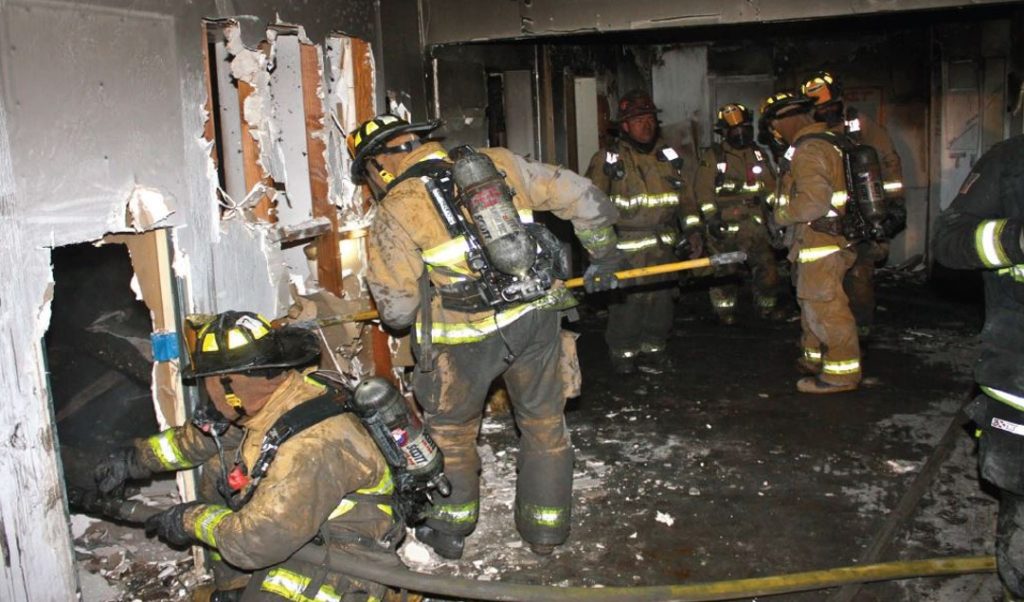 A firefighter with no breathing apparatus during overhaul inspection post fire
A firefighter with no breathing apparatus during overhaul inspection post fire
A labour union at a manufacturing facility had contacted the OHCOW ergonomists for assistance with a situation involving the operators of Class IV forklifts. The employer wanted to implement a reverse driving policy to replace a long-standing practice of having the forklift operators drive in a forward-facing direction whenever possible. This long-standing practice meant that forklift operators were driving in reverse for only brief moments such as backing out of a tractor-trailer or reversing the front forks out from under a load. The forklift operators were resistant to the proposed policy based on a concern that a significant increase in their reverse driving time would have a negative impact on the longer-term health of their backs and necks.
The union estimated that the forklift operators were working at a 95% utilization time with the current practice of driving in a forward direction whenever possible. The employer saw an opportunity to decrease the utilization time by having the forklift operators carry twice the load. This would require reverse driving because an operator’s view is severely obstructed in a forward direction by a double load. The union felt the reverse driving policy would trade off longer-term health concerns for immediate productivity gains.
The employer acknowledged that they had little information on the risks associated with reverse driving, but in a seemingly contradictory statement to the union, the employer suggested that having forklift operators reverse drive for up to 50% of a shift was a best practice that seemed to be working out well in other facilities. When the union requested to see any data that would support the employer’s claim that the best practice was working out well, they received an assortment of documents. The union forwarded the documents to the OHCOW ergonomists for review and comment.
One such document provided by the employer as justification for a significant increase in reverse driving appeared to caution against it. It was a report issued through the U.S. National Institute for Occupational Health & Safety. The report concluded that driving a forklift in reverse may lead to an increased risk of neck problems, primarily because of excessive neck rotation to extreme positions.(1)
Another document was an ergonomic assessment conducted by an ergonomist retained by the employer. After a review of the report, the OHCOW ergonomists were of the opinion that the analysis tool used was not well suited for evaluating the risk of concern, namely the twisting of the back and neck.
Following the review of another report, the OHCOW ergonomists offered an alternative view of the data and performed an evaluation using a more up-to-date analysis tool.
The union also provided the OHCOW ergonomists with various images that they believed to be fair representations of the body postures assumed by their forklift operators when driving in reverse. The OHCOW ergonomists examined the images with regards to lines-of-sight, back and neck postures, etc.
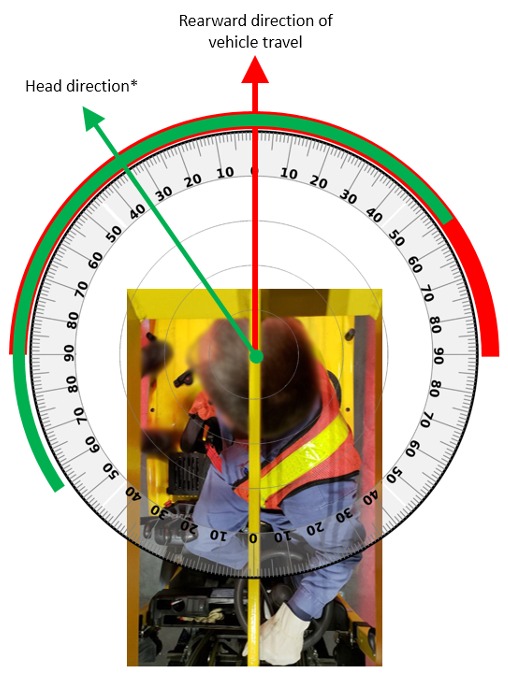
The OHCOW ergonomists eventually suggested a visit the facility to observe the forklift operations first hand and to discuss with the employer the possibility of collaborating on a more in-depth investigation and analysis of the situation. Unfortunately, the union was not able to obtain such an invitation.
Over time, the union developed the impression that the feedback from OHCOW, which was being communicated to the employer, was being discounted. The union requested that the Ontario Ministry of Labour visit the workplace and provide clarity on the issue. The Ontario Ministry of Labour issued an opinion following their investigation.
Ultimately, the employer was able to implement a reverse driving policy with up to 50% of the driving time in reverse when the forklift is equipped with a 10% swivel seat. The OHCOW ergonomists were of the opinion that maintaining the status quo of forward-facing driving was the most prudent path for the employer to continue following. The union conceded that any increase in injuries that may develop as a result of an increased exposure to reverse driving may be the only motivation for the employer to reconsider the new policy.
The OHCOW ergonomists wanted to gain some understanding into how the issue of reverse driving was being viewed through the lens of Ontario’s workplace insurance system. A search was conducted of the publically available decisions by the Ontario’s Workplace Safety & Insurance Appeals Tribunal. A ruling in favour of an injured worker had stated the following:
“The act of turning his head to either the left or right and holding it there for the 30-45 seconds required to back up from the warehouse to the loading dock, and then again in backing out of the tractor-trailer after dropping off the load, creates a strain on the neck that is not experienced in day-to-day life. The fact that this activity was repeated in excess of 50 times per shift, 6 shifts per week, over several years, unavoidably increases the impact of this strain, and it is reasonable to conclude that this in itself would aggravate any pre-existing cervical degenerative disc condition.”(2)
Considering the pervasive use of forklifts across North America and globally, there is a surprising scarcity of quality research on the issues of driving forklifts in reverse. It is hoped that the future will include more published research into this issue that will assist workplaces to make more informed decisions.
(1) NIOSH [2018]. Evaluation of forklift operators’ risk of musculoskeletal disorders. By Lu M-L, Werren DM, Ramsey JG, Brueck SE. Cincinnati, OH: U.S. Department of Health and Human Services, Centers for Disease Control and Prevention, National Institute for Occupational Safety and Health, Health Hazard Evaluation Report 2012-0182-0208- 3300, http://www.cdc.gov/niosh/hhe/reports/pdfs/2012-0182-0208-3300.pdf.
(2) Workplace Safety and Insurance Appeals Tribunal. DECISION NO. 1916/06. https://www.canlii.org/en/on/onwsiat/doc/2006/2006onwsiat2476/2006onwsiat2476.html
The worker came to the clinic in 2017 to be assessed for a potential claim for Noise Induced Hearing Loss. At that time the OHCOW NIHL calculator tool was used and the level of loss did not meet WSIB criteria for their NIHL policy, as his loss was below 22.5 dB in both ears once it was adjusted for his age, which was 67 years old at the time of this audiogram. This patient was however still working and was advised to have another audiogram done as per the suggestion of the audiologist. The worker started his career as an instrument mechanic in the maintenance department of a petrochemical plant and then worked in the building of new plants from 1966 to 1974. He worked alongside construction teams and was exposed to the noise of air tools and heavy equipment and once it was up and running large compressors were used, all of which produced loud noise. He went on to work in the commissioning of a new heavy water plant from 1974 to 1977. This was again a very noisy environment. From 1977 to 2013 he worked as a project designer, inspecting and commissioning petrochemical plants, working for several hours per day out in the field. From 2013 until his retirement in 2019 he worked 4 days per week on contract for an engineering firm mainly inspecting and commission furnaces and compressors in the petroleum and energy sector. He would be exposed to the noise of furnaces, compressors, pumps and steam lines.
The worker came back to OHCOW in January of 2021 for re-assessment of his NIHL, based on two more recent audiograms completed in 2019 and 2020. One just before he retired and the other following his retirement. The audiogram that was done closest to the time he retired and was no longer exposed to noise was input into the OHCOW NIHL calculator tool and was found to have an age adjusted loss in his right ear of 26.75 dB and in his left ear of 24.25 dB.
| Right Ear | Hz (sound level) | Left Ear |
| 20 | 500 | 15 |
| 20 | 1,000 | 15 |
| 35 | 2,000 | 25 |
| 50 | 3,000 | 60 |
| 125 | SUM (add results) | 115 |
| 31.25 | RESIDUAL (divide by 4) | 28.75 |
| -4.5 | AGE ADJUSTMENT (minus 0.5 db) for every year over the age of 60) | -4.5 |
| 26.75 | dB Loss | 24.25 |
The OHCOW physician submitted a Physicians Report (form 8) to the WSIB for this patient due to his level of loss and classic notch pattern seen in NIHL. This claim was denied by the WSIB in the fall of 2021. The WSIB used the audiogram from 2019, which was closest to the time he retired in June 2019 but stated that he had insufficient loss as per the WSIB noise induced hearing loss policy 16-01-04. They had calculated his loss from that 2019 audiogram to be 19.25 dB in his right ear and 24.25 dB in his left ear after adjustments for his age and based on bone conduction readings not air conduction, which would not have met the minimum eligibility criteria of 22.5 dB in both ears. They did however determine that the type of loss he had was consistent with noise induced hearing loss. They also estimated that through his employment, based on how long and how often he worked in noise and the associated noise levels provided by the Canadian Centre of Occupational Health and Safety (CCOHS) database and the National Institute for Occupational Safety and Health (NIOSH) database, that he would have been exposed to an 8-hour daily average noise level of at least 86 dB for a period of 41.66 years. As a result, it was felt that his levels of noise exposure meet the WSIB policy criteria of continuous exposure to 90 dB of noise for 8 hours per day, for a minimum period of five years, or the equivalent.
Assistance was given to the patient in the completion of his intent to object form to the denied WSIB claim. This decision was objected to on the basis that his loss, as supported by the audiologist was sensorineural in nature and had no suggestion of any conductive elements. Also, with the potential margin for error with regards to the placement of a bone oscillator and with the pattern of loss showing a notch in the higher frequencies which is typical of NIHL, the bone conduction numbers should not have been used to calculate the level of loss sustained. It was argued that the calculations should have been done solely using the air conduction numbers and therefore should have shown a 26.75 dB loss on the right side and 24.25 dB loss on the left side after the age adjustment is applied.
The WSIB reconsidered the initial decision to deny this Noise Induced hearing loss claim based on the intent to object arguments and had their WSIB audiologist review the audiograms.
The decision was then overturned and the claim for Noise Induced Hearing loss was allowed, with entitlement to health care benefits. This means that the patient will have a lifetime entitlement to hearing aids, including their repair, ongoing maintenance, and replacement when required, as well as batteries and hearing assistive technologies.
This worker’s patience and persistence through a long process paid off in the end, as he is wearing his hearing aides and this has immensely improved his quality of life.
The worker contacted OHCOW to inquire about assistance for her home workstation. The worker stated she was experiencing upper extremity and low back discomfort which she attributed to a change in how her duties were performed because of the pandemic. Previously as a piano and vocal instructor she was moving more during lessons however now that lessons are being taught virtually, she remained seated most of the day. She is using an adjustable office chair which allows her to move between the piano, laptop, and tablet. The laptop is positioned on a table and the tablet on the piano bench. Moving between each of the workstations which are at different heights, while ensuring she is in view of the camera was causing her to assume awkward postures. See workstation setup below:
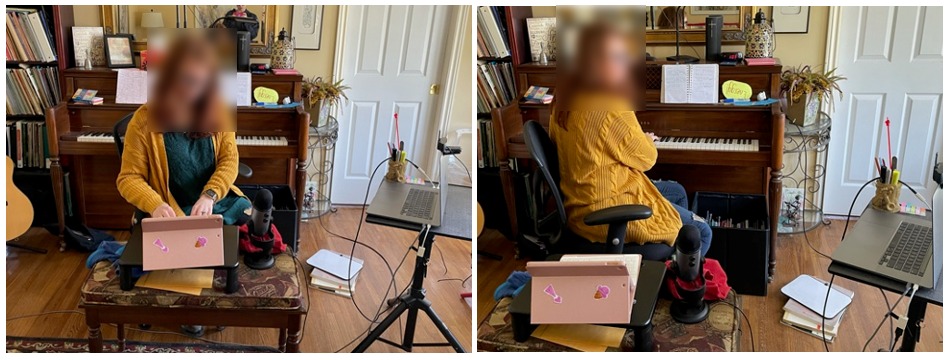
The OHCOW Ergonomist had the worker complete a questionnaire to identify the worker’s current discomforts; equipment used; and the daily duties required. This information allowed the ergonomist to understand the requirement of the job and how the workstation was being used. In addition to the questionnaire the worker provided pictures of the workstation which assisted in the identification of the hazards. Once these materials were reviewed a virtual assessment took place. During this assessment the duties were discussed in detail and solutions to minimize and eliminate the hazards were discussed. Recommendations were provided following the assessment and the OHCOW ergonomist worked with the equipment provider and worker to ensure proper workstation setup. The main concern with the workers original setup was that neutral posture could not be achieved due to the multiple surfaces being used, in combination with improper equipment to achieve optimal working postures. During the virtual assessment the worker expressed the need to stand to instruct students during vocal exercises as well as type notes during instructional periods. The need to be able to move the workstation was also indicated as it would act as a barrier between students during in-person lessons once they reconvened. Recommendations included a portable sit/stand workstation, a separate monitor, a compact split keyboard, and a right-handed mouse. Below is the workers new setup:
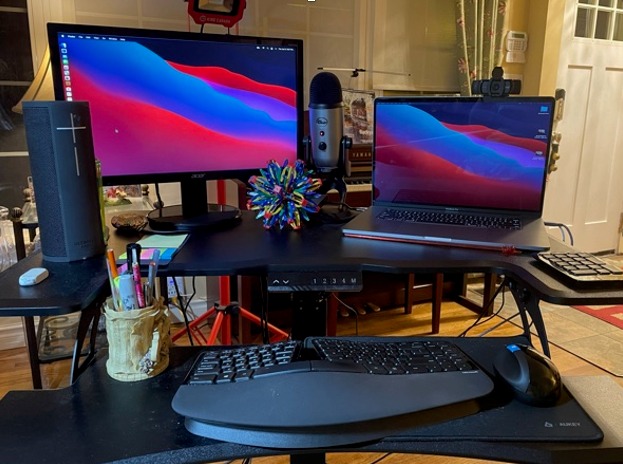
Below is a statement from the worker following the implementation of the recommendations:
“I wanted to give you an update on how much your advice has helped me and in turn helped others! What a difference the desk, double monitor, keyboard, etc. has made. I’m actually so much more comfortable at that space now, than I am the desk I would use for personal use.
Additionally, I got asked to be interviewed about all this and there was a 10-minute video put together by our certifying board that has been shared internationally to help others!
Thank you for all this, you have not only helped me but a bunch of other musicians and teachers!”
Below is a link to the video the worker had titled, “The Ergonomics of Online Teaching Studios” for the Royal Conservatory of Music:
https://vimeo.com/theroyalconservatory/review/549037692/2c571cf54c
A worker was experiencing upper extremity and back related discomfort as a result of pushing a student in a wheelchair at a school for sustained periods during daily walks. The worker did not want to let their discomfort become a barrier to the student’s accessibility to daily walks. Previous interventions were unsuccessful in developing an ideal solution that allowed the worker to comfortably push with wheelchair. Past recommended adjustments made to the wheelchair led to the student being put at risk of injury when the anti-tip bars were temporarily removed. A solution was required that could be mutually agreed upon by the student and their parents, the union, the worker, and the school board.
An OHCOW Ergonomist analyzed a previous ergonomic report that the schoolboard had completed in order to identify the root causes of the ergonomic hazards that the worker was exposed to while pushing the student in their wheelchair. Previous ergonomic analysis indicated that the force required to push the wheelchair was found to be minimal and low risk. The primary risk factor in this case was the posture that the worker was required to assume for the duration of the push. Anti-tip bars on the back of the wheelchair interfered with the workers stride while pushing the chair and resulted in the worker having to lean and reach forward to avoid stride interference. The handles of the chair were located 36” above the ground and were horizontal, resulting in non-neutral wrist postures while pushing.
An OHCOW ergonomist researched various wheelchair attachments that would allow for the worker to push the wheelchair in a neutral posture while ensuring that the attachment could not endanger the safety of the student. Through discussion with the Health and Safety representative at the schoolboard, the model of the wheelchair was identified. Ultimately, the OHCOW ergonomist contacted the wheelchair manufacturer to determine if they had any attachments that would satisfy the needs of all stakeholders. The manufacturer of the wheelchair directed the OHCOW Ergonomist to a product called the ‘Ergo Stoller Handle’. This product was height adjustable to allow neutral pushing posture, affordable, easily added/removed as required, and did not pose any safety risks to the student.
The OHCOW Ergonomist’s assessment and recommendations were put into a report that was presented to all stakeholders. Ultimately all stakeholders approved of the solution. The recommendation of purchasing the ‘Ergo Stroller Handle’ will be evaluated for all workers who are required to perform a sustained push of a wheelchair as a proactive solution to minimize exposure to musculoskeletal risk factors.
In addition to meeting the safety requirements of all stakeholders, the solution also serves to meet the accessibility standards of the student according to the Accessibility for Ontarians with Disabilities Act (AODA). Under the AODA, “barrier” means anything that prevents a person with a disability from fully participating in all aspects of society.
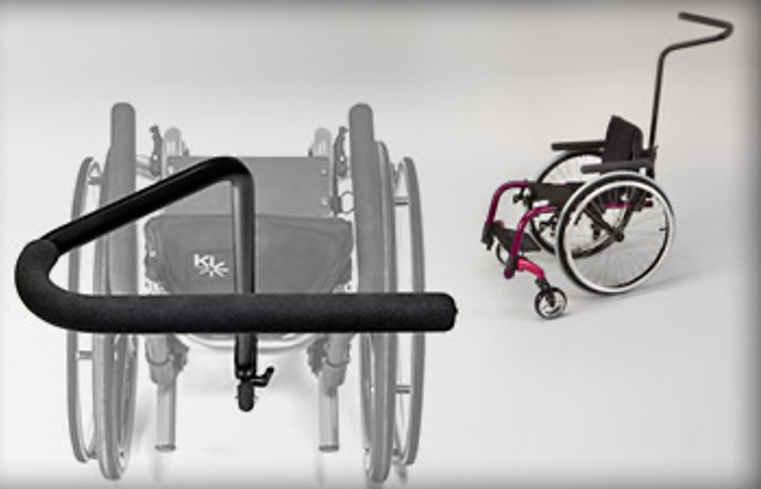
The following key priorities are based on the Ontario Disease Action Plan (ODAP) and are also the basis for the restructuring/rebuilding of our new website:

OHCOW’s clinical work, large cluster investigations, and vulnerable worker lens, provide a unique perspective on a full circle occupational illness/disease prevention approach (primary, secondary and tertiary) and continue to provide leadership to Ontario’s Occupational Illness Prevention System Focus.
Though the global pandemic has created continuing demands for the latest science and prevention tools in response to COVID-19, it has also fostered an unprecedented popular culture awareness of Occupational Illness/Disease and the Hierarchy of Controls which can and must be leveraged to the longer latency priorities of the Occupational Illness Prevention Plan.
 OHCOW’s clinical work, large cluster investigations, and vulnerable worker lens, provide a unique perspective on a full circle occupational illness/disease prevention approach (primary, secondary and tertiary) and continue to provide leadership to Ontario’s Occupational Illness Prevention System Focus.
OHCOW’s clinical work, large cluster investigations, and vulnerable worker lens, provide a unique perspective on a full circle occupational illness/disease prevention approach (primary, secondary and tertiary) and continue to provide leadership to Ontario’s Occupational Illness Prevention System Focus.
Though the global pandemic has created continuing demands for the latest science and prevention tools in response to COVID-19, it has also fostered an unprecedented popular culture awareness of Occupational Illness/Disease and the Hierarchy of Controls which can and must be leveraged to the longer latency priorities of the Occupational Illness Prevention Plan.
Building from the success of the Occupational Disease Action Plan (ODAP) and The Ontario Auditor General report’s recommendation to continue with the ODAP activities, while assessing its effectiveness and making adjustments as necessary, the Occupational Illness Prevention Steering Committee was created. It aligns with Ontario’s OHS Strategy – Prevention Works. While the mandate of this strategy has been to reduce illnesses and fatalities associated with occupational diseases in Ontario workplaces, the emphasis on General Occupational Disease Awareness has evolved to one of exposure reduction and control. This is achieved through:
These strategies improve recognition, reduce the burden and incidence of occupational illness by preventing or controlling the exposures responsible for the illnesses, and acknowledge and address the problem of under-reporting of occupational illness. This problem was identified in the Demers report and has been acknowledged widely in other literature.
- Theory of Change / Logic Model Working Group – the framework for the new occupational illness prevention plan based on data and evidence analysis
- Prioritity-Setting
- A Ranking exercise combined with evidence/data tables resulted in a recommendation to stage priorities over a 5-year period grouped:
*Welding Fumes was also included due to stakeholder feedback
- Updated OHCOW Occupational Exposure Limit (OEL) Adjust Tool which allows workplace parties to calculate the adjusted workplace exposure limit for an unusual or extended work shift in support of the MLTSD Occupational Health Regulatory Modernization Amendments and revised to include Health-Based option extending beyond compliance.
- XXII World Congress on Safety and Health at Work- Poster Presentation with CCOHS: Occupational Disease from Clinics to Prevention-Moving towards a national platform through collaboration (preventoccdisease.ca)
- OHCOW’s Occ-tober Event (see more details below)& World Cancer Day-Needles in a Haystack-Rare Cancers in the Workplace Webinars
- OHCOW partnering with CCOHS, IHSA & BCCSA- Silica Control Tool Pilot Program. Ontario contractors embark on silica tool pilot project. Sixty contractors in Ontario are taking part in a 12-month pilot testing the merits of a digital tool developed to quickly prepare control plans to mitigate the potential health risks of overexposure to crystalline silica. See article by Daily Commercial News and apply on our website.
- CHAP Risk Tool A Workplace Tool for Identifying and Prioritizing Workplace Chemical Hazards
- The Occupational Disease Labour-Management Committee, supported by the Infrastructure Health and Safety Association (IHSA), held a seminar, attended by 70 stakeholders, on Regulation 33: Control of Exposure to Biological or Chemical Agents, featuring Paul Demers, who shared the results from their study on strategies to reduce future burden of cancer in the Ontario construction industry.
- Occupational Cancer Research Centre (OCRC) Occupational Disease Stats Database
- Centre for Research Expertise in Occupational Disease (CREOD) created a Skin Health at Work toolbox
- OHCOW participation on Project Advisory Panel to CSA Group research report on Asbestos Management in Canada: Assessing the Need for a National Standard, available for free download in English and French
- Updated Humidex-Based Heat Stress Calculator and Plan for indoor workers
- OHCOW informs the National Chemical Management Plan. Health Canada Gap Analysis: Tools Available to Employers-The Protection of Workers from Exposure to Chemicals
- Additional content to the Physician/Clinician’s Toolkit in collaboration with CCOHS with consult from the Physician’s Advisory Committee with participation from the Occupational and Environmental Medical Association of Canada (OEMAC), the Occupational Medical Specialists of Canada (OMSOC) and the Community of Practice in Occupational Medicine under the College of Family Physicians of Canada (CFPC).

For more than two years, we have been navigating through the global health crisis of COVID-19. This pandemic has dramatically changed Canadians lives, and continues to challenge all of us, both personally and professionally. We are proud of the ways OHCOW has continued to support our employees, our clients – the workers of Ontario, and their workplaces. We remained open for business throughout the pandemic, shifting and learning to work remotely to protect both our staff and our patients. We’ve supported our employees with work from home arrangements, and frequent communication to help them manage through this ongoing challenge. Through the commitment, determination, and ingenuity of our employees, we are able to be there for our stakeholders, for our partners, and for the workers of Ontario during another challenging year.
Indeed, the biggest uncertainty we face remains the pandemic, with many Ontario communities and workplaces still experiencing high numbers of COVID-19 cases. Our internal COVID-19 Response Team (CRT) comprised of an interdisciplinary panel of Nurses, Doctors, Hygienists, Client Service Coordinators and Leadership continues to monitor the COVID-19 situation and provide guidance to our Provincial Health and Safety Committee and Leadership for when and how staff and patients might return to the office. OHCOW and our CRT are focused on what matters, which is looking out for the safety of our employees, their families, and our communities – both at home and at work.
Throughout 2021-2022, OHCOW continued to develop new and reliable COVID-19 tools for use in the workplace and at home and provide "lessons learned" and up to date science in our OCC-COVID Webinar Series.
Our OCC-COVID Webinar Series continued throughout the year, drawing lessons from the COVID-19 experience to date, endeavouring to help workers and workplaces navigate through the pandemic and mitigating workplace risk into the future. Our series featured speakers from a range of backgrounds and disciplines who presented current information on the COVID-19 situation, and provided guidance and direction for dealing with it in our workplaces and public settings. Sessions included:
...just to name a few.
See our OCC-COVID Webinar Series page for all of the year’s sessions, including videos and posted slide decks.
A series of infographics developed to help simplify the messaging around what can be done to stop the spread of COVID-19. Topics included:
Based on Public Health Fundamentals for Homes and Workplaces
This study examined trends over time in the prevalence of anxiety and depression among Canadian nurses: 6 months before, 1-month after, and 3 months after COVID-19 was declared a pandemic
OHCOW conducts occupational disease cluster investigations for a number of reasons:
Cluster investigations also raise public awareness about occupational disease and health and safety in general, promoting prevention throughout the workplace and industry. In addition to the current investigations described below, OHCOW continues to follow up on past investigations and to plan future work in the steel, paper, mining and other industries, as well as health care.
The research related to the Rubber Worker Project has continued through 2021/22 as we have tried to gather information that might be relevant to exposures from widening sources. Given the closure of the Kitchener plants more than 15 years ago, a lot of effort is required, including visits and to the City of Waterloo Planning Department, the University of Waterloo Archives, the Waterloo Public Library Archives, and numerous freedom of information requests to the Ministry of Labour, Training and Skills development. The highlight of the year, was the organization of a covid-safe outdoor in-person meeting with retirees in late September as well as an individual visit later in the year, to begin mapping plant storage and operations over time. Other activities included:
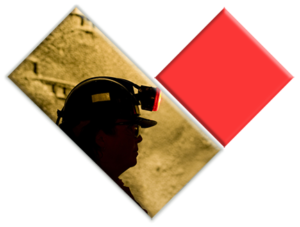 OHCOW continues to investigate health issues in a group of over 500 registered workers who were subjected to the mandatory inhalation of finely ground aluminum dust (McIntyre Powder) during the period between 1943 and 1979. These “treatments” were intended to prevent silicosis in gold and uranium mining and milling. Despite being nearly universal in these industries during the period, the unusual and counterintuitive practice was little studied before OHCOW’s involvement.
OHCOW continues to investigate health issues in a group of over 500 registered workers who were subjected to the mandatory inhalation of finely ground aluminum dust (McIntyre Powder) during the period between 1943 and 1979. These “treatments” were intended to prevent silicosis in gold and uranium mining and milling. Despite being nearly universal in these industries during the period, the unusual and counterintuitive practice was little studied before OHCOW’s involvement.
In 2021-22, our work to provide workers with answers about the consequences of McIntyre Powder exposure prioritized in-depth reviews of existing clinical literature, analysis of MPP miners with common diagnoses, and contributing to the published scientific literature.
Sarcoidosis: An OHCOW systematic literature review on sarcoidosis as an occupational disease was accepted for publication by the prestigious journal CHEST in June 2021. https://journal.chestnet.org/article/S0012-3692(21)01093-X/fulltext In the past, the condition has been considered idiopathic, but a growing literature supports a relationship to environmental factors, including occupational exposures. Application of this research to the consideration of MPP-exposed miners was explored in an OHCOW case series report on 12 miners with definite or probable sarcoidosis accepted or publication by the American Journal of Industrial Medicine in February 2022. https://onlinelibrary.wiley.com/doi/full/10.1002/ajim.23333
Cardiovascular Disease: OHCOW has initiated joint work with the Occupational Cancer Research Centre a study matching data on miners in the Ontario Mining Master File with and Ontario health database records to examine cardiovascular disease diagnoses in MP-exposed versus MP-unexposed miners. Work on the analysis and presentation of the results is ongoing.
Neurological Diseases: A similar OCRC health records matching study initiated by the WSIB after OHCOW publicized the number of registrants suffering from such diseases has previously led the Board to recognize Parkinson’s Disease as an occupational disease caused by McIntyre Powder exposure. In January 2022, the path to compensation was further eased when McIntyre Powder was added to Schedule 3 of the Workplace Safety and Insurance Act regulations. This creates a presumption that whenever an MP-exposed worker is later diagnosed with Parkinson’s Disease, the worker or surviving family members are entitled to compensation. This is the first addition to the schedule since 1994. OHCOW’s work investigating the possible relationship between MP and other neurological conditions such Alzheimer’s Disease and Motor Neuron Disease continues.
Pulmonary Fibrosis: As of March 2022, OHCOW has also begun a systematic review of existing literature regarding pulmonary fibrosis, which is often classified by treating physicians as idiopathic even in workers with significant occupational exposures to substances known to cause lung fibrosis. The goal of this work is to refine, as far as possible, a process for distinguishing cases that are truly idiopathic from those that are likely related to occupational exposures.
Throughout the year, OHCOW has continued to gather medical records for individual medical reviews, to assess individual exposures in occupational hygiene reports and to assist workers and family members in filing claims with WSIB for a variety of conditions (including cancers, neurological, respiratory, cardiovascular, musculoskeletal, and autoimmune disorders) potentially related to exposures in the mining environment.
McIntyre Powder Project history: Two articles were accepted for publication in New Solutions Journal in 2021-22. These deal with the history of McIntyre Powder - “Trading One Risk for Another” https://journals.sagepub.com/doi/full/10.1177/10482911211037007 - and the lived experience of exposed miners – “Breathe Deep, Boys” https://journals.sagepub.com/doi/full/10.1177/10482911221079056
Running from 2002-2004, the Dryden Weyerhaeuser Paper Mill Recovery Boiler #4 project resulted in the exposure of hundreds of building trades workers to a recurring plume of toxic emissions. At the request of some of the involved unions, OHCOW conducted intake clinics in Dryden and Thunder Bay in November 2004, resulting in the registration of nearly 400 patient files and the filing of 160 health professional reports to WSIB, primarily regarding reported neurological effects. This was followed by the completion of a general report on the nature of the exposures and in-depth assessments on some of the most affected workers.
In 2021, the Dryden Committee of the Thunder Bay District Injured Workers Support Group (TBDIWSG) requested that OHCOW further investigate the RB4 exposures and potential health issues. Nearly 400 letters were sent to the last known address of registered workers, along with approximately 200 attempts to reach workers or next-of-kin by telephone.
Due to the passage of time, confirmed contact was made with less than one-quarter of the workers and families, but this has resulted in the reactivation of over 60 files for further follow-up, as well as contacts from several workers who were not part of the original intake clinic group. In 2021-22, we began the process of collecting information, with over 4000 pages of Ontario Ministry of Labour documents relevant to the Dryden RB4 project reviewed and organized by OHCOW staff, along with over 50 completed individual worker surveys, and the initiation of the process to obtain 20 existing WSIB claim files.
The collection and analysis of information regarding exposures and reported health effects will continue in 2022-23, to be followed by a process to address the findings, including health effects in individual workers related to their careers in the building trades more generally.
The Neelon Casting foundry operated in Sudbury under several owners and names from the mid-1970’s until it was closed in 2007, three years after it was bought by US-based competitor The Affinia Group. After noticing a concerning number of deaths and illnesses from potential occupational diseases on a Facebook group of past Neelon employees, United Steelworkers (USW) Local 2020 Disability Services representative Jessica Montgomery contacted OHCOW in July 2020 for help in providing objective hygiene and medical information and individual assessments to former Neelon workers, who number more than 2,000.
As a result of Local 2020’s efforts through the Facebook group and local media, 279 new occupational disease claims have been made to WSIB by the end of 2021-22. OHCOW has provided information from our past work with individual Neelon workers, organized government inspection records and other historical information gathered by the local union into an electronic library for reference and for sharing with the WSIB and collected more than 125 online work history questionnaires and 60 detailed health histories interviews with past Neelon Casting workers.
In collaboration with Jessica and other USW 2020 staff, we have also organized an advisory committee of Neelon workers to draft a historical exposure report detailing the work processes and conditions throughout the history of the Neelon Casting facility, with drafting led out by Dale and Bob DeMatteo who have developed similar reports on the General Electric and Pebra/Ventra Plastics plants in Peterborough. Release of this report is expected in the Summer of 2022.
OHCOW has been actively engaged with the Peterborough community since 2004, with particular focus on workers at General Electric and Pebra/Ventra Plastics and their families.
Work during this year focused primarily on the assessment of 50 Pebra/Ventra files opened or reactivated during 2020-21. This process identified several diagnostic categories and exposures requiring more detailed investigation. Multidisciplinary teams of OHCOW staff have been working on the following issues, engaging outside experts as needed: female reproductive issues, salivary gland cancer, pancreatic cancer, breast cancer, chronic toxic encephalopathy (CTE), and the identification of endocrine disrupting chemicals (EDCs) and asbestos exposures at the Pebra/Ventra plant.
This year we also initiated detailed follow up contacts with scores of General Electric workers and families to update health and WSIB claims information in order to prepare for a new round of work in the coming year on the individual and common issues arising in the hundreds of occupational cancer and non-malignant lung disease cases from that plant.
For more about our Peterborough work, including reports on exposures at the GE and Pebra/Ventra Plastics plants, visit our website here.
OHCOW hosted it’s 7th Annual Occ-tober Event as a Webinar Series, running five Fridays in October and November (Lung Month).
Dr. Joel Moody
Ontario Chief Prevention Officer
Arif Jetha
Institute for Work & Health
Katherine Kirkland
Association of Occupational and Environmental Clinics
Genevieve Luensman and Barbara Wallace
NIOSH
Brier Musson
Ministry of Labour, Training and Skills Development (MLTSD)
Victoria Arrandale
University of Toronto (UofT)
Katherine Kirkland
Association of Occupational and Environmental Clinics
Barbara Hales and Bernard Robaire
McGill University
Paul Demers
Occupational Cancer Research Centre (OCRC)
Kevin Hedges
Occupational Health Clinics for Ontario Workers (OHCOW)
Cheol-Heon Jeong
Southern Ontario Centre of Atmospheric Aerosol Research
Melanie Gorman-Ng
BCCSA
Kimberly O’Connell
Occupational Health Clinics for Ontario Workers (OHCOW)
Thomas Tenkate
Ryerson University
John Oudyk
Occupational Health Clinics for Ontario Workers (OHCOW)
Paul A. White
Health Canada
Nancy Bradshaw
Ministry of Labour, Training and Skills Development (MLTSD)
Kimberly O’Connell
Occupational Health Clinics for Ontario Workers (OHCOW)
Eduardo Huesca
Occupational Health Clinics for Ontario Workers (OHCOW)
Updated in 2021!
Brought to you by OHCOW, and the Occupational Disease Action Plan Contributors, the newly updated OEL Adjust Tool allows the calculation of the adjusted workplace exposure limit for an unusual or extended work shift which has been adapted using the methodology set out in the Guide for the Adjustment of Permissible Exposure Values for Unusual Work Schedules (March 2015), published by Quebec’s Institut de recherche Robert-Sauvé en santé et en sécurité du travail (IRSST).
This method, used in the Province of Quebec and referenced by the ACGIH and other health and safety organizations, considers toxicological information such as sensitization, irritation, organ toxicity, reproductive system toxicity and teratogenicity, in addition to exposure and recovery times.
Irregular work shifts are now commonplace in many industries and the standard eight-hour work day/40 hour work week (which has been the basis for the time-weighted average (TWA) occupational exposure limits) is often not the reality. To address this change, exposure standard adjustments have increasingly become an essential component in workplace exposure assessment.
In addition to provide adjustment for Ontario compliance limits, OHCOW used its own research, data published by GESTIS and the ACGIH to assist in determining the lowest exposure limit easily accessible for occupational hygienists, advanced JHSC members or workers with additional training. Occupational exposure limits vary by jurisdiction. Such limits are published by a number of different governments or private organizations. The limits are deemed to reflect the understanding and interpretation by those jurisdictions of the science used in determining a limit for workers.
OHCOW considers the Brief and Scala method to be more protective of worker's health. Adjustment Codes are applied only to a Time Weighted Average (TWA) Limit. Short-term exposure limits (STEL) and ceiling limits (C) are not subject to the adjustment principle. To overcome this limitation in those cases where there is no TWA OHCOW has applied the 3/5 rule as found in Regulation 833/90 in reverse by taking the STEL or C value and dividing the value to estimate a TWA to be used for extended shifts only.
The TWA adjustment process applies only to nominal schedules with shifts of no less than 7 hours, not continuous for 24 hours and no less than 40 hours per week. In no case can an adjusted average exposure limit (AAEL) be greater than the current regulatory standard nor the health-based limit.
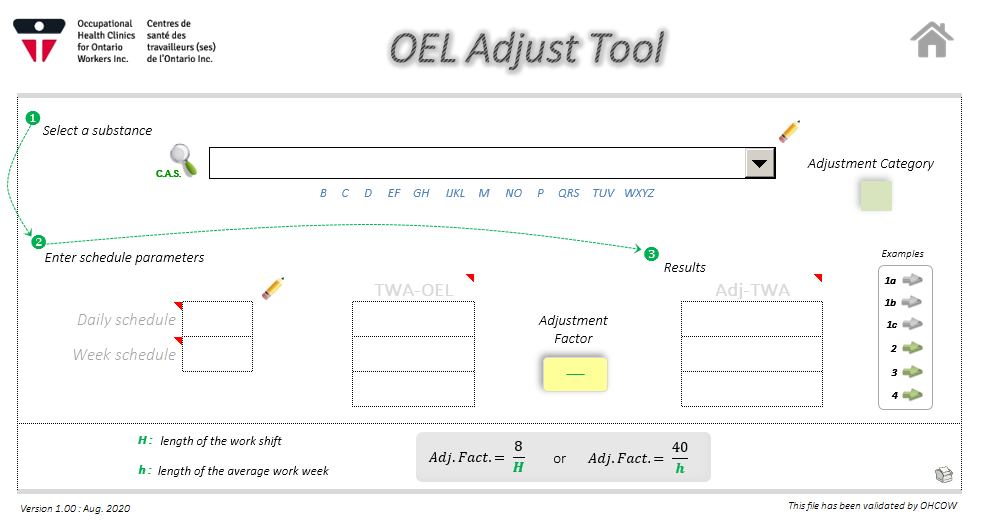
A guidance summary has been prepared to allow the user to review the health-based limit proposed and in the case of limits proposed by OHCOW reference to research used in determining the limit.
The Noise-Induced Hearing Loss (NIHL) Audiogram Calculation Tool was designed to assess values based on the worker’s audiogram to clarify if their NIHL meets the minimum requirement for establishing a NIHL claim with the Ontario Workplace Safety and Insurance Board (WSIB). The NIHL Audiogram Calculation Tool allows anyone who has had an audiogram conducted, to input their results into the calculator to determine if those calculations fall within the criteria set out in the WSIB policy for NIHL # 16-01-04.
Sample Audiogram (left) with Values Entered Into the NIHL Audiogram Calculation Tool (right)
This helpful tool can be found at:
www.ohcow.on.ca/occupational-illness/exposures/noise-induced-hearing-loss-nihl/calculation-tool/
Created by: Kelly Brown RN, DOHN, Ivan Bauer B.Sc.N., RN, Jennifer McMillan (CSC)
As part of International Noise Awareness Day 2021, OHCOW produced an infographic presenting the types and effects of noise, control measures and goals, as well as the benefits of noise control.

Prevention programs are a proactive way to find and fix workplace hazards before workers are injured or become ill. These programs can be effective at reducing injuries, illnesses, and fatalities.
Workplace Ergonomics, Musculoskeletal Disorders and Work Environment are all key topics of the prevention picture.
Updated for the modern workplace, remote (mobile) workstations, and new technology

Now available in two formats (Web and PDF) to meet your needs!
Previously, OHCOW developed the Office Ergonomics Handbook that was available in print form as well as on our website as a downloadable PDF. This popular handbook serves as a guideline for office ergonomics but had not been updated since 2008.
The working population is more reliant on technology than ever before, and computer use is no longer limited to the traditional office. Almost every industry today requires use of computers to perform some aspect of the job. The COVID-19 pandemic further increased the use of computers in alternative settings such as home workstations. Virtual meetings have now replaced many in person interactions. Due to these factors the Ergonomists at OHCOW recognized that Office Ergonomics is more important now than it has ever been before.
To continue to provide current, reliable, and expert guidance in office ergonomics, the OHCOW Ergonomists updated, revised, and modernized the old Office Ergonomics Handbook and created a new and improved Office Ergonomics Reference Guide. The content of the new guide:
It has been created with independent modules (listed below) in an easily accessible web format. A downloadable PDF version is also available.
With access to an easily understandable and usable Reference Guide, workers of Ontario can learn more about office ergonomics and begin correctly setting up their own workstations.
View the various sections of the Web-based Office Ergonomics Reference Guide
using the links below:
Covid-19 challenged employers and employees as they strove to keep functioning amid the global pandemic, many of whom shifted to working remotely from home.
Under these conditions, OHCOW pivoed to prevent injuries occurring and/or increasing in severity for those setting up workstations in their home environment.
Initially, OHCOW’s response was to provide quick tips and suggestions for those working from home through knowledge translation webinars. Tools demonstrating inexpensive interventions were also offered. However it did not take long to realize that the pandemic would continue on, and that temporary measures were not enough.
The experience and knowledge of OHCOW Ergonomists allows them to determine areas of a concern with a work station immediately upon entering a work area. Virtual assessments consisting of a questionnaire and a video call turned out to be effective. This became time-consuming as information provided on heights, and locations of equipment was not specific.
As a result, the Anthropometric Calculator was created. Anthropometric measurements assist not only with design options for specific individuals but also general populations. In addition to design, they can also determine potential sources of mismatch between specific individuals, or populations, by comparing equipment heights and distances to a worker, or group of workers. The calculator combines four different anthropometric databases, providing a comprehensive and concise data set of anthropometric dimensions.
By entering the height provided by a worker into the calculator, the ergonomist can determine the body segments lengths with 95% accuracy. With this information, in addition to the questionnaire and photographs of the worker sitting at their work area and simulating work, the ergonomist can provide the recommendations not only faster but also tailored to the dimensions of the work, again with 95% accuracy. The results are presented by gender at birth, in table or graphical form, and available in either metric or imperial.
With respect to information collected, both the virtual and anthropometric approach allowed the Ergonomists to see:
| Virtual Assessment | Anthropometric Calculator Method | |
| Equipment Used (chair, monitor, keyboard, mouse, wrist rest, mouse rest, keyboard tray) |
|
|
| Comparison of worker to their equipment |
|
|
| Ability to specify sources of mismatch |
|
|
| Pain/discomfort |
|
|
Using screen captures or the provided pictures, OHCOW Ergonomists can visually demonstrate areas of concern.
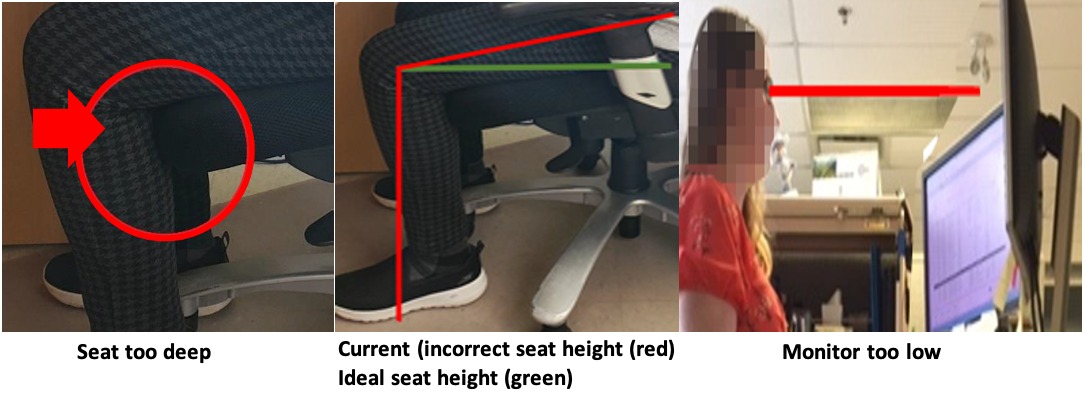
As an example, using a 5’11” male, his height was entered into the anthropometric calculator.
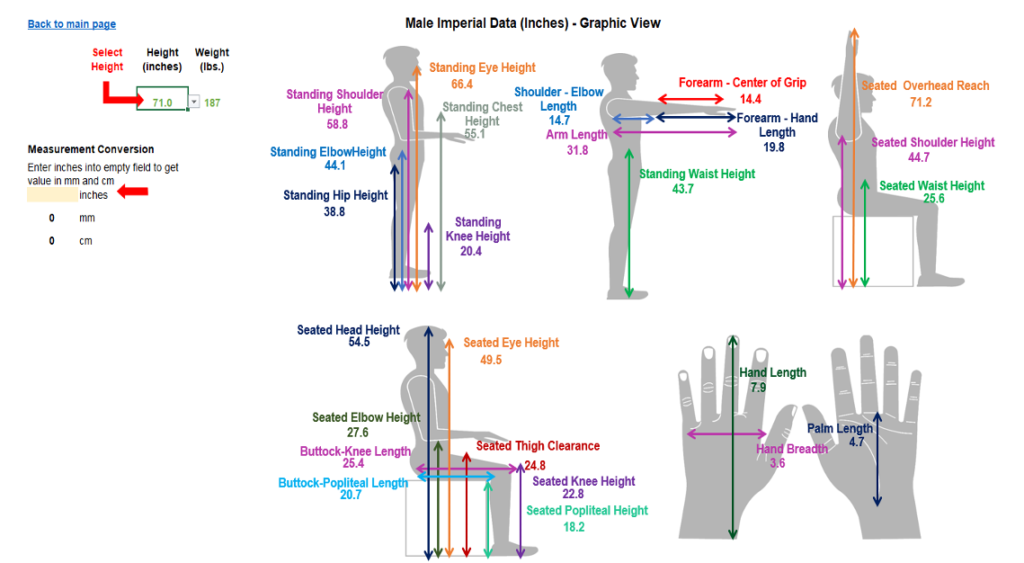
Example of body length segments for a 5’11” male
When compared to a visual virtual assessment, the Ergonomists could now state with 95% confidence:
| Virtual Assessment | Anthropometric Calculator Method | |
| Chair |
|
|
| Keyboard \Mouse |
|
|
| Monitor Height |
|
|
| Monitor Distance |
|
|
As a result, not only were the Ergonomists able to provide specific recommendations (with 95% accuracy) for a worker, the joint health and safety committee had the information they needed to ensure that equipment purchased would match the physical dimensions of the worker.
OHCOW developed and delivered the following presentations:
VIEW PRESENTATION [PDF]
The following tools and apps were developed / updated:
The correct sized mouse will help to reduce awkward postures and contact stress on the hand and wrist, thus helping to prevent injuries.
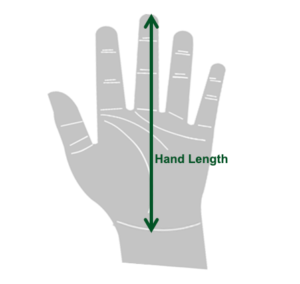
Wearing the proper sized gloves is an important step in preventing injuries. When dealing with a physically diverse work force, the one-size-fits-all approach to gloves does not work.
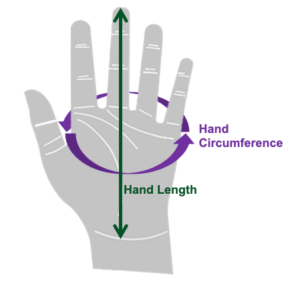
Exploring New Horizons

The phrase RSI is a ubiquitous term used to describe an ache or pain located anywhere in the body. “RSI Day” tends to draw focus towards upper limb disorders only, especially those related to computer work. RSIs (also known as Cumulative Trauma Disorders and Musculoskeletal Disorders) are but a portion of the occupational health domain.
The event this year was the most successful RSI Day event that the Occupational Health Clinics for Ontario Workers (OHCOW) has hosted in the event’s 23-year history. Due to COVID-19 restrictions, it was held virtually. Similar to 2021, it went from a full one-day event into a four-week webinar series for the entire month of February. Each week consisted of a different theme to address multiple issues relation to Ergonomics and musculoskeletal disorders.
Registration for the individual sessions combined was greater than any previous year
with 1212 registrants!
Week 2
Integrating Components for a Return-to-Work Program
Understanding the Elements of a Physical Demand Analysis (PDA)/ Physical Demand Description (PDD)
Components of a Functional Abilities Exam (FAE)
Utilizing A PDA/PDD and FAE to Determine Return-to-Work (RTW)
779
registrants
International Participation
This pie chart shows the top 10 countries in the international distribution of participation in OHCOW's Repetitive Strain Injury (RSI) events:
Other participating countries include:
Argentina • Mexico • Austria • Netherlands • Belgium • New Zealand • Brazil • Nigeria • Chile • Panama • Colombia • Peru • Egypt • Philippines • France • Poland • Georgia • Saudi Arabia • Germany • Scotland • Hungary • Slovakia • Iran • South Africa • Israel • Spain • Lithuania • Turkey • United Arab Emirates • Malaysia

Mental health at work is crucial for worker wellness and engagement. The crisis, challenges and trauma of 2020-2021 (and continuing in 2021-22) have put mental health front and center for workplaces. Dialogue and discussion are the key to help strengthen workplace mental health initiatives and make the future of work, in a post-pandemic world, psychologically safe and healthy.
OHCOW has been a prevention system leader in Workplace Mental Health since 2011, when we worked with academic and labour partners to research survey tools, finding the Copenhagen Psychosocial Questionnaire, and building the Mental Injury Toolkit. This year we released the companion guide for the toolkit: Preventing Mental Harm in the Workplace. These tools, along with our StressAssess Survey can be used as a starting point to help ignite that discussion.
Visit our newly designed Workplace Mental Health web page for additional resources and watch our Mayday, Mayday webinar series for all the updates.
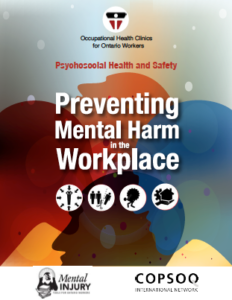
Unhealthy stress, harassment and violence are modern-day workplace challenges created by working conditions that do not consider the psychological and physical health of workers. The impact of these conditions is widely recognized and documented in media, research, and government documents. Workplace Mental Health is now a priority and prevention of workplace mental harm is necessary.
Workers and managers must find a strategy that shifts away from fault and blame and focusses on the working conditions that create the problem. A common language is needed to describe the issues, as well as a reliable tool to measure them, and a broad commitment to change conditions to reduce unhealthy stress, harassment, and violence.
Our Preventing Mental Harm in the Workplace Guide provides information that can help workers and organizations that are concerned about protecting workers mental health, walk a pathway towards a safer, healthier work environment. It is only through collaborative action that psychologically safe and healthy workplaces can be built.
MAYDAY, MAYDAY is an internationally recognized cry for help, and Mayday itself celebrates the contribution of workers over the world. OHCOW’s 5th Annual Symposium on Workplace Mental Health, Stress and Injury Prevention was held as a 5-week webinar series that drew on speakers from across Ontario and beyond to highlight and share solutions to Workplace Mental Health, Stress and Injury Prevention with considerations for what the new and restored ‘normal’ may be. Weekly sessions included:
In this webinar John Oudyk, OHCOW Occupational Hygienist, discusses the results of the Public Health Agency of Canada survey, outlining some of the contributing risk factors to individuals’ mental health, and then ties in the missing link – workplace risk factors.
From the results of OHCOW’s Pandemic Response Surveys, John shows the effect that workplace protective measures have had on workers mental health throughout the pandemic. He highlights how meeting workers COVID-19 protection needs minimizes the impact of the pandemic on workers’ mental health and well-being.
The main goal of this 11 month multi-phase project funded by the Ontario Ministry of Agriculture, Food and Rural Affairs (OMAFRA), was to create an inventory of available mental health and psychosocial wellbeing supports and services available to Latinx and Caribbean International Agricultural Workers (IAWs) in Ontario, and to distribute findings to these workers as soon as possible. From there, the project sought to better understand key issues related to worker mental health and psychosocial wellness by conducting a scoping review of scientific literature; structured interviews with IAWs and other stakeholders, including community groups, employers, employers’ associations, primary health care clinics, mental health organizations, mental health initiatives specializing in work with migrant communities, and legal clinics; individual and group consultations; and reviews of secondary sources from all the stakeholder groups.
The project was developed under two conceptual frameworks: Social Determinants of Health (SDOH) and Occupational Health and Safety (OHS). Project members considered the SDOH when identifying resources that support and protect the mental health of IAWs, and when searching for services and supports that treat and manage poor mental health symptoms and distress. Initially, 89 organizations, services and supports were identified and included in eight regional resource posters developed for IAWs, English and Spanish versions. These posters were distributed to workers during the 2021 agricultural season. The project sought feedback on these posters consulting IAWs and additional stakeholders. As a result, updated posters were created with additional information, along with a ninth poster for an additional Ontario region. The final version of these posters can be accessed here, as well as 10 videos in both English and Spanish to support worker navigation through the poster information. These updated resources will be distributed to Ontario international agricultural workers during the 2022 season.
The services and supports listed are a snapshot of what is currently available, and issues related to the accessibility and appropriateness of some supports and services remain, with many lacking contextualization to the specific experiences and needs of Ontario IAWs. In various regions, supports and services for IAWs are scarce, or inaccessible, and the project found service gaps and reach limitations and challenges related to limited or precarious funding.
The scoping literature review focused on research from Canada, the US and other migrant worker ‘host’ countries, as well as countries of worker origin. The objective was to learn more about migrant worker populations, factors shown to affect their mental health and psychosocial wellbeing, services and interventions carried out to support and protect mental health, as well as to provide care to those facing mental health challenges. 160 articles in English and 20 in Spanish were extracted and reviewed. The most prominent topics identified were related to the work environment of these populations, as well as their experience as migrants in host countries and communities, and related OHS and mental health risk factors and interventions. Studies on mental health among migrant workers were focused on depressive symptoms and sleep challenges. Other conditions identified as strongly influencing mental health included housing, food insecurity, social isolation, discrimination and difficulties accessing medical and mental health care.
A total of 58 interviews were conducted as part of the project, including twenty-six (26) with workers from Mexico and Caribbean Countries, twenty (20) with community support groups, seven (7) with employers hiring IAWs, two (2) with employer associations, seven (7) with Ontario health centres, three (3) with mental health initiatives specializing in work with migrant communities, and four (4) with staff from Ontario legal clinics.
Interviews with Ontario IAWs identified numerous mental health challenges associated with working and living in Canada on temporary contracts, including psychosocial challenges related to work environments, housing conditions, employment issues, financial concerns, physical health, COVID-19 related policies and procedures, concern for family back home, grief, job insecurity, fear of reprisal and repatriation, lack of access to health care and social services, barriers in accessing legal services, gaps in services available. Interviews with community support groups and other stakeholders found mental health challenges among IAWs and gaps in local services and resources for these workers across all regions of focus.
The report highlights examples of promising practices supporting IAWs across Ontario, followed by a discussion of gaps and limitations. The report concludes with recommendations aimed at various stakeholders. Responses to the social determinants of health faced by IAWs need to be central components of policies and practices that seek to improve primary, mental/ psychosocial, public, and occupational health outcomes for these workers in Ontario.

OHCOW is a unique organization, focused on occupational health (OH) and injury and illness prevention, with an array of medical and scientific professional staff. Our Migrant Farm Worker program, operating since 2006 from the South-Central Clinic in Hamilton, is even more unique in its combination of professional OH knowledge with community outreach and support to agencies (including Community and Public Health), as well as clinical services to workers and OH knowledge translation to farms. Plus, we have become involved over the years with a number of researchers currently formed into the Migrant Farm Worker Expert Working Group (EWG) who have been researching and advocating for the recognition and fair treatment of this group of workers for many years.
2021/22 saw the expansion of our reach and impact through the OMAFRA and ESDC/Kairos funded projects which follow. In addition, several other initiatives bore fruit:
READ REPORT
See also TORONTO STAR ARTICLE
.
Developed in partnership with The Neighbourhood Organization-Toronto
We welcomed, and greatly appreciated, involvement in two Kairos “Empowering Temporary Foreign Workers During COVID-19” projects in 2021/22, which added significant dimension and reach to our prevention efforts. The Project team consisted of our MFW Program Community Outreach and Program Coordinator, Occupational Health Nurse and Director, three subject matter experts in occupational, public and worker mental health (and program evaluation) and four outreach workers who could reach the Thai, Caribbean, Latinx and Filipino communities.
The main goals and achievements included:
The majority of the resources developed by the Projects can be found here. We originally proposed to conduct two webinars on COVID-19 and the occupational health and safety laws that apply to it, and hold stakeholder meetings focused on reprisal protection under those laws. However, we recognized early on that there was a thirst for information about vaccine safety, as well as about WSIB in the context of COVID-19. Additionally, there existed a significant lack of knowledge about the occupational health and safety framework for injury and illness prevention in Ontario workplaces and its application to a viral epidemic. Thus, our focus shifted to providing information on these topics.
Along the way, we supported workers and community groups with information and knowledge to help address the gaps they identified. We delivered, and contributed to, webinars and capacity building workshops, and connected workers and community groups to stakeholders and service agencies who provided additional support. This included connecting workers to WSIB, healthcare services, vaccination clinics, and healthcare professions who have provided vaccine related information and consultation to workers.
Both projects gathered important knowledge and data on COVID-19 and other OHS hazards affecting temporary foreign workers, through questionnaires, interviews and outreach which allowed us to focus on priorities and areas of particular need. Our work supporting the empowerment of temporary foreign workers has been recognized as valuable, and continues with a third ESDC/Kairos funded project in 2022/23.
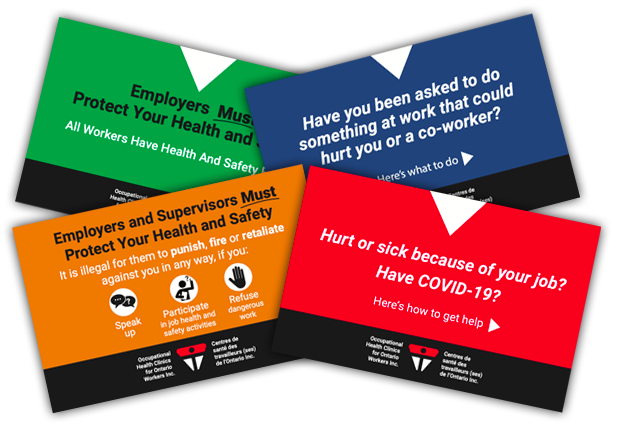
These wallet-size reference cards contain helpful information for workers who need to exercise their rights for a healthy and safe work environment.
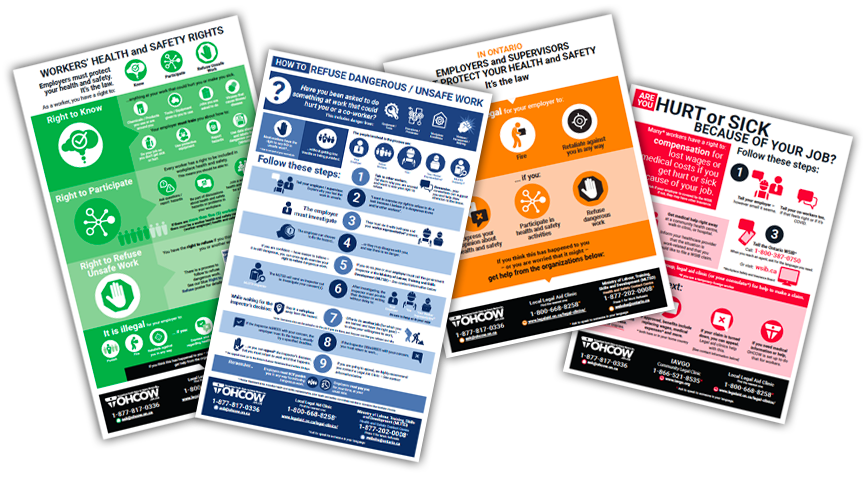
These infographics expand the content from the wallet cards into a more visual poster-like presentation.
OHCOW continues to develop helpful and informative tools and resources for use by our clients in improving their workplace situation.
The following apps, tools and calculators were newly developed or updated during 2021-22:
OHCOW’s Excel-based Anthropometric Calculator brings together a number anthropometric databases* in an attempt to provide the most comprehensive and concise data set of anthropometric dimensions.
Anthropometric measurements are a series of quantitative measurements that are used to assist with design options for both specific individuals and general populations, and to assess potential sources of mismatch between specific individuals or populations by comparing equipment heights and distances to a worker or group of workers.
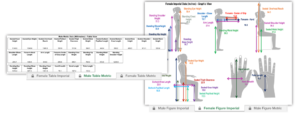
When using the calculator you have the option of working in Table or Figure (Graphic) View,
as well as Imperial or Metric measurements, using the spreadsheet tabs.
The following video provides an overview of how to use this powerful tool:
An Excel-based tool created as a simple means for determining what precautions should be taken to protect workers from cold stress-related adverse health outcomes.
Simply enter the outdoor temperature and wind speed into the calculator. and the tool then calculates the adjusted or wind chill temperature for you. It also provides you with a listing of relevant health concerns as well as suggested precautions. There is even a table for estimating wind speed if you don’t have access to that information.
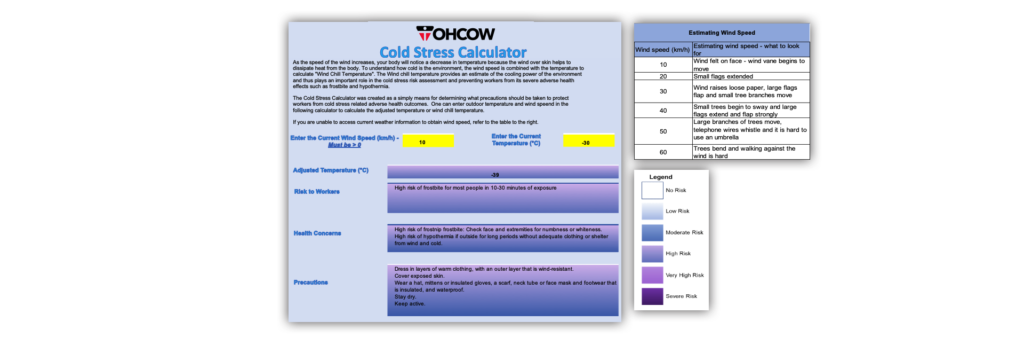
DOWNLOAD THE CALCULATOR [v1c)
Measuring instructions and comparison chart to assist you in determining proper sizing for a computer mouse
Using a proper size mouse is an important step to preventing injuries. The correct sized mouse will help to reduce awkward postures and contact stress on the hand and wrist.
Developed by OHCOW, this calculator determines the health risk of exposure to diesel exhaust
This tool is still in the development stages but an electronic copy can be obtained by contacting Kevin Hedges or John Oudyk.
Instructions will be provided on the proper use of the calculator along with important limitations of its use.
A web-based version of this new calculator is also in the development stages for release in 2022.
Measuring instructions and comparison chart to assist you in determining proper sizing for work gloves
Wearing the proper sized gloves is an important step in preventing injuries. Poor fitting gloves can increase the amount of force required by the muscles, cause pressure on the hands, limit dexterity, increase perspiration, and reduce productivity. The one-size-fits-all approach to gloves doesn’t work when you’re dealing with a physically diverse work force.
Working in extreme conditions can be hazardous to your health.
Heat and humidex are no exception.
The new, online Humidex-Based Heat Stress Calculator uses temperature and humidity percentage (%) to calculate humidex and provides recommended actions.
A poster to promote awareness of this workplace hazard is also now available.
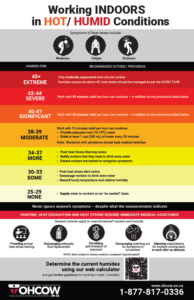
Minimize mouse use, increase keyboard efficiency, and reduce ergonomic risk using keyboard shortcuts tutorials.
Different computers/operating systems have different keyboard shortcuts.
Choose the one that applies to you:
When downloading the files above, you will be redirected to a Dropbox where you can download the zip files containing the tutorials as well as a supporting PDF.
The files are then stored on your computer so that you can refer back to them when needed.
Each ZIP file is approximately 245 MB.
The Noise-Induced Hearing Loss (NIHL) Audiogram Calculation Tool was designed to assess values based on the worker’s audiogram to clarify if their NIHL meets the minimum requirement for establishing a NIHL claim with the Ontario Workplace Safety and Insurance Board (WSIB). The NIHL Audiogram Calculation Tool allows anyone who has had an audiogram conducted, to input their results into the calculator to determine if those calculations fall within the criteria set out in the WSIB policy for NIHL # 16-01-04.
Sample Audiogram (left) with Values Entered Into the NIHL Audiogram Calculation Tool (right)
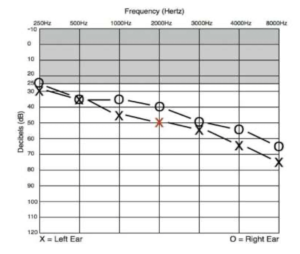
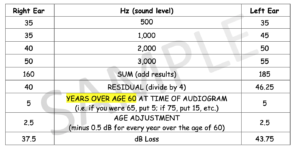
Updated in 2021!
Brought to you by OHCOW, and the Occupational Disease Action Plan Contributors, the newly updated OEL Adjust Tool allows the calculation of the adjusted workplace exposure limit for an unusual or extended work shift which has been adapted using the methodology set out in the Guide for the Adjustment of Permissible Exposure Values for Unusual Work Schedules (March 2015), published by Quebec’s Institut de recherche Robert-Sauvé en santé et en sécurité du travail (IRSST).
This method, used in the Province of Quebec and referenced by the ACGIH and other health and safety organizations, considers toxicological information such as sensitization, irritation, organ toxicity, reproductive system toxicity and teratogenicity, in addition to exposure and recovery times.
Irregular work shifts are now commonplace in many industries and the standard eight-hour work day/40 hour work week (which has been the basis for the time-weighted average (TWA) occupational exposure limits) is often not the reality. To address this change, exposure standard adjustments have increasingly become an essential component in workplace exposure assessment.
In addition to provide adjustment for Ontario compliance limits, OHCOW used its own research, data published by GESTIS and the ACGIH to assist in determining the lowest exposure limit easily accessible for occupational hygienists, advanced JHSC members or workers with additional training. Occupational exposure limits vary by jurisdiction. Such limits are published by a number of different governments or private organizations. The limits are deemed to reflect the understanding and interpretation by those jurisdictions of the science used in determining a limit for workers.
OHCOW considers the Brief and Scala method to be more protective of worker's health. Adjustment Codes are applied only to a Time Weighted Average (TWA) Limit. Short-term exposure limits (STEL) and ceiling limits (C) are not subject to the adjustment principle. To overcome this limitation in those cases where there is no TWA OHCOW has applied the 3/5 rule as found in Regulation 833/90 in reverse by taking the STEL or C value and dividing the value to estimate a TWA to be used for extended shifts only.
The TWA adjustment process applies only to nominal schedules with shifts of no less than 7 hours, not continuous for 24 hours and no less than 40 hours per week. In no case can an adjusted average exposure limit (AAEL) be greater than the current regulatory standard nor the health-based limit.

A guidance summary has been prepared to allow the user to review the health-based limit proposed and in the case of limits proposed by OHCOW reference to research used in determining the limit.
I am text block. Click edit button to change this text. Lorem ipsum dolor sit amet, consectetur adipiscing elit. Ut elit tellus, luctus nec ullamcorper mattis, pulvinar dapibus leo.
OHCOW’s primary tool for helping workplaces understand (and ultimately control or mitigate) the factors which contribute negatively to the mental health of their staff is a survey tool built on the Copenhagen Psychosocial Questionnaire with additional questions developed over several years of administration in Ontario workplaces. During the pandemic this survey has proved more popular than ever, with many workplaces large and small accessing the tool, plus several of those requesting customized analysis and support by one of our staff. Don’t hesitate to get in touch if you think your workplace could benefit from more information or assistance with this well-validated tool.
StressAssess sample workplace edition:
182 accesses of which there were 27 completed responses
StressAssess personal edition:
Approximately 2100+ accesses and about 226 completed responses
StressAssess workplace edition account activity:
An Excel-based tool to assist you in determining the adequacy of the ventilation in your workspace*
*Tool can be used to evaluate classrooms, single offices and small meeting rooms.
The levels in this tool are based on classroom occupancies.

NOTE: Downloading the spreadsheet using Firefox as your browser may result in an error message about the extension.
You can open it anyway, or download the file using Chrome or Edge as your browser.
Watch John Oudyk’s presentation of OHCOW’s Classroom Ventilation Tool at a live webinar:
The following Ventilation Checklist can be used as a guide to assess and improve ventilation in rooms and buildings. It is recommended for Joint Health and Safety Committee members, Health and Safety Representatives, Managers, Supervisors and Workers since everyone has an interest in clean air as a part of a healthy workplace.
Pertinent questions are suggested that can be used to assess the suitability of ventilation in the workspace/building that is to be occupied. It follows the traditional health and safety R.A.C.E. framework: Recognize • Assess • Control • Evaluate
IMPORTANT NOTE
This OHCOW Ventilation Checklist v. 2.0, is being released as a BETA version.
As such, we welcome your feedback and can adjust this guidance after it has been applied to assess and improve ventilation in your workplace.
Please provide your feedback about modifications / improvements to Kevin Hedges (khedges@ohcow.on.ca) so that improvements can be made, and that the guidance provided is both iterative and practical with continuous improvement.
 OHCOW distinguished itself in 2021-22 with world-class research published in peer reviewed journals.
OHCOW distinguished itself in 2021-22 with world-class research published in peer reviewed journals.
In June 2021 the medical journal Chest, a publication by The American College of Chest Physicians, published an OHCOW systematic literature review on sarcoidosis, entitled "Sarcoidosis: An Occupational Disease?" The paper, by L. Christine Oliver, MD and Andrew M. Zarnke, BSc can be found here.
Sarcoidosis is a granulomatous (inflammatory) lung disease. Before modern epidemiologic studies and advanced diagnostic tools, its cause was not determined. Since then, its strong causal association with occupational exposures has been established, as well as gene-exposure interactions. Results of studies to date show damage to the immune systems of occupationally exposed sarcoidosis cases, compared with control cases. Previous research on exposure to silica and silicates, World Trade Center dust, and other metals, are referred to in this paper. When the cause of sarcoidosis is occupational, the worker can be removed from the area, and effective treatment can be sought. Furthermore, it can launch prevention initiatives aimed at protecting other workers.
Another paper, "Sarcoidosis in Northern Ontario hard-rock miners: A case series" published in the American Journal of Industrial Medicine in February 2022, can be found here. With Oliver and Zarnke being two of the researchers, the paper also refers to the growing literature supporting the relationship between the disease and environmental factors, including occupational exposures. An OHCOW case series report showed the application of this research, where 12 miners with definite or probable sarcoidosis were studied in light of their exposure to McIntyre Powder (MP).
The paper "McIntyre Powder and its potential contributions to cardiovascular disease risk: A literature review through the McIntyre Powder historical lens," published in the American Journal of Industrial Medicine, can be found here. In this research Zarnke and Oliver look at the period from 1943 to 1979, when mine workers in Ontario were exposed to McIntyre Powder (MP) in their workplace, often in high concentrations. Originally developed to prevent silicosis in miners, MP is a fine aluminum powder. The high airborne concentration that miners were exposed to, however, caused lung damage along with the respirable dust miners breathed as they worked in the mines. It is also suggested that workers exposed to MP are at an increased risk for cardiovascular disease (CVD).
OHCOW Occupational Hygienist John Oudyk co-wrote the paper "The Association between the Perceived Adequacy of Workplace Infection Control Procedures and Personal Protective Equipment with Mental Health Symptoms: A Cross-sectional Survey of Canadian Health-care Workers during the COVID-19 Pandemic," published in The Canadian Journal of Psychiatry that can be found here.
The health care sector has been under increased strain since the pandemic, and workers from this group were studied in light of the strict requirements of personal protective equipment (PPE) and infection control procedures (ICP) during the pandemic. How did the perceived adequacy, or inadequacy, of these protections effect their mental well-being?
Another paper Oudyk co-wrote, "Labour Market Attachment, Workplace Infection Control Procedures and Mental Health: A Cross-Sectional Survey of Canadian Non-healthcare Workers during the COVID-19 Pandemic", appeared in the Annals of Work Exposures and Health and can be found here. The research studied a wider range of labourers, the move to remote work, and those who lost their jobs during the pandemic. Those staying home were, of course, at lower risk of infection. The researchers sought to understand the relationship between working arrangements, infection control programs (ICP), and symptoms of anxiety and depression among Canadian workers, not specifically working in healthcare.
Both of the above papers saw results that suggest strong employer-based infection control strategies can reduce mental health symptoms among workers, both in health-care and other sectors. This needs to be remembered as economies re-open.
Another OHCOW paper studying the relationship between working conditions and mental health is "Assessing the Psychosocial Work Environment in Relation to Mental Health: A Comprehensive Approach," and appears in the Annals of Work Exposures and Health and can be found here.
The psychosocial work environment is impacted by a wide range of multiple factors. How do these stressors impact workers' mental health, in areas where they cluster? Groups of individuals with similar psychosocial work environments were profiled with regards to how those environments were related to burnout, stress and cognitive strain. A strong connection was found between psychosocial job stressors and mental health. Such stressors do indeed cluster in the Canadian labour market, and addressing them can alleviate mental health issues for workers.
Moving into 2023, OHCOW continues to contribute to research that seeks to understand and find solutions for occupational injuries and illnesses.
OHCOW uses the following channels to connect with it’s vast audience which includes workers, employers, consultants, Health & Safety Committees and Representatives:
Over the 2021-22 fiscal year, OHCOW hosted a wide variety of webinars covering a wide range of topics.
The following links to our flagship events provide event details and access to the resources generated from each event:
The following podcasts were produced by OHCOW during the 2021-2022 reporting period:

Launched: May 12, 2021
Length: 19:13 | Listens: 173
This podcast helps workers understand the importance of gathering information from their current workplace regarding their exposures and start the process for looking at previous workplaces as well. This podcast reviews a list of items you can and should be looking for when starting your workplace exposure portfolio.
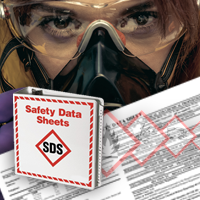
Launched: December 23, 2021
Length: 30:31 | Listens: 92
OHCOW hygienists James Miuccio and Sonia Lal have a candid discussion on Safety Data Sheets: about their formulation and the end users’ experience. They talk about controls or lack of when there is insufficient information on the Safety Data Sheet. They share some real-life examples from workplaces which were affected by chemical exposures and how SDSs helped or hindered the process for corrective action.

Launched: February 22, 2022
Length: 15:41 | Listens: 118
This podcast shines the spotlight on the “Health” side of “Health and Safety” for workers while building the awareness of the many workplace variables which could be adversely affecting your health. Knowing your work environment, your rights as a worker, as well as insight to help you identify health symptoms sooner, can all help prevent the onset of occupational illness.
The following infographics and posters were produced by OHCOW during the 2021-2022 reporting period:
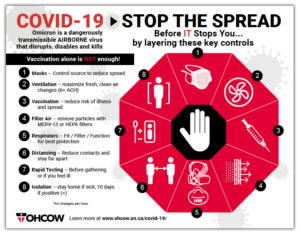
An infographic that highlights eight key controls that will help stop the spread of COVID-19.
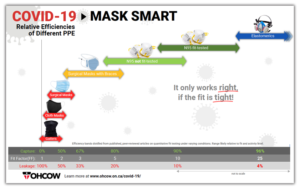
A bar graph created from peer-reviewed data that shows the relative efficiencies of various types of masks / respirators – from ineffective gaiters and cloth masks to surgical masks (with and without fit-braces), to fitted and non-fitted N95 respirators to highly effective elastomerics.
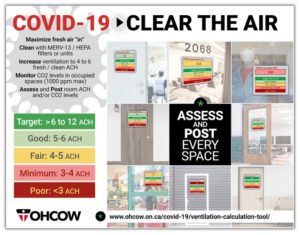
An infographic that outlines five ways to ensure that the air in your work or home space is clear and safe and highlights the importance of assessing and posting the ventilation rate in shared spaces such as work or meeting spaces, classroom or other shared spaces.
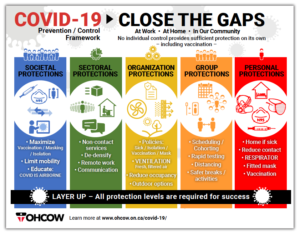
An infographic that highlights five (5) layers of control (Societal, Sectoral, Organizational, Group and Personal) that will help stop the spread of COVID-19.
It’s in the air – What can you do to avoid the virus?
An infographic that outlines some basic approaches, in addition to vaccines, for helping to stop the spread of COVID-19.
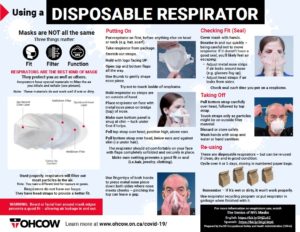
An infographic prepared by OHCOW to support workers and workplaces at a critical time, presenting simple instructions for putting on, checking fit (seal), taking off and re-using a respirator.
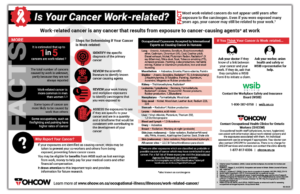
An infographic outlining several facts about work-related cancer, steps for determining if your cancer is work-related, some of the most common occupational exposures that cause cancer in humans* as well as what to do if you think your cancer is work-related. It also provides reasons for reporting your cancer.
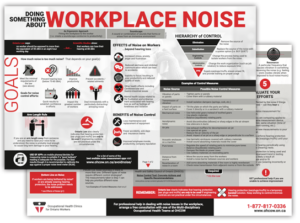
An infographic presenting the types and effects of noise, control measures and goals, as well as the benefits of noise control.

A poster that outlines the risks of working in hot / humid INDOOR environments, and provides recommendations for actions to prevent injury / illness.
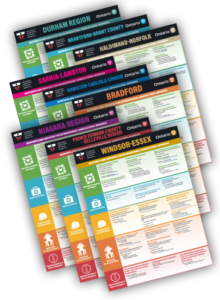
A series of nine colourful posters* help workers find the health and psychosocial assistance they need while working in Ontario’s Agriculture Industry
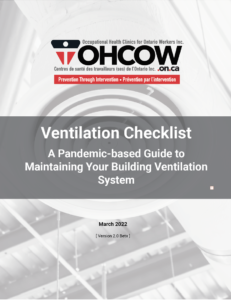
For use as a guide to assess and improve ventilation in rooms and buildings.
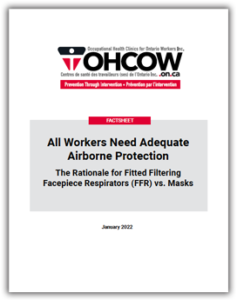
The Rationale for Fitted Filtering Facepiece Respirators (FFR) vs. Masks
It’s time to rethink and upgrade masks to filtering facepiece respirators (FFR) for workers the community and your family.
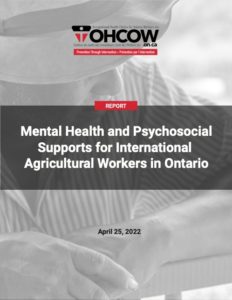
A report prepared by OHCOW for the Ontario Ministry of Agriculture, Food and Rural Affairs (OMAFRA).
OHCOW connects with its vast audience which includes workers, employers, consultants, Health & Safety Committees and Representatives, using the following methods:
In 2021-22 we completely rebuilt our website to improve the delivery of our content to our users.
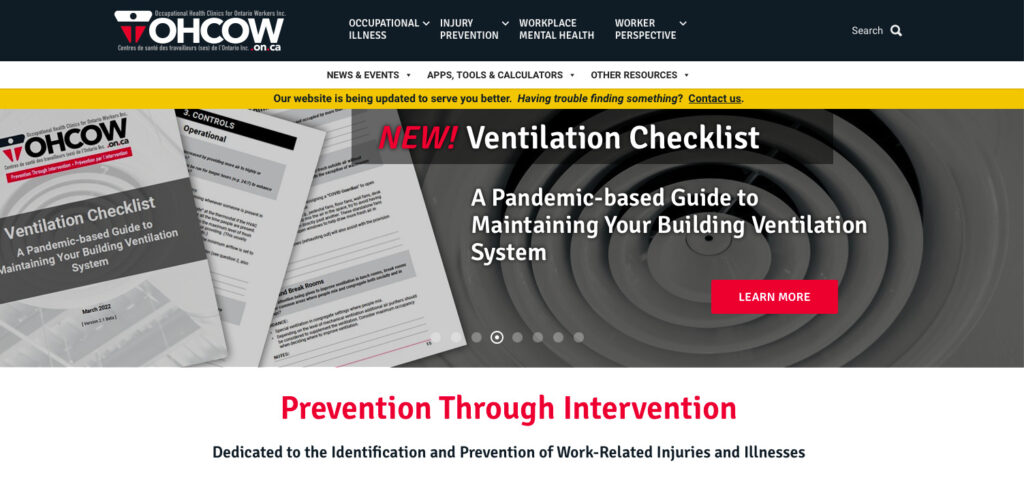
The main navigational structure was redesigned in line with the changes to the Occupational Illness Prevention Plan with a secondary navigation bar providing access to event information, our popular apps, tools and calculators as well as a mega menu that serves up all of our resources categorized by the type of resource.
Proper post creation, categorization and tagging of all resources was undertaken to improve the cross-referencing and search capabilities of the site.
Our website is constantly growing and evolving as we continue to improve how we promote and provide access to all of our resources and events.
Our users and clients stay up to date on all of OHCOWs offerings using our two popular e-newsletters.
In early 2022 we updated the look and feel of The Lens making it more visual and engaging:
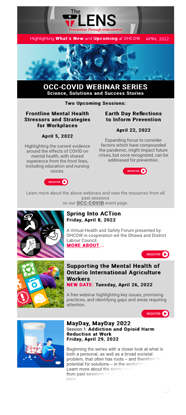
Issues: 6
Subscribers: 4,184*
Open rate: 31.3%*
Click-through Rate: 5.6%*
*Average across 6 issues
Issues: 6
Subscribers: 4,349*
Open rate: 31.7%*
Click-through Rate: 4.3%*
*Average across 6 issues
To learn more about our newsletters, view past issues and/or subscribe,
visit Newsletters / Events Bulletin
Through our website’s News & Events section, our users and clients can learn about cluster projects, exposures, scientific/medical studies, upcoming webinars, current occupational health issues and planned events where they can participate live or review postings of previous presentations.
In 2021-22 we modernized the organization with a new logo (including Spanish and Thai versions),
as well as other related communication pieces.
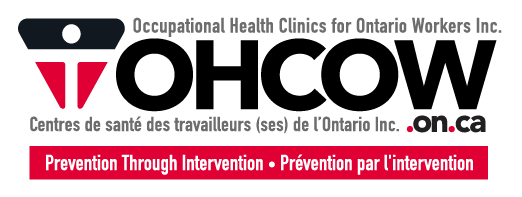


OHCOW partnered with the following organizations throughout the 2021-22 year to deliver current, meaningful content to our audience:
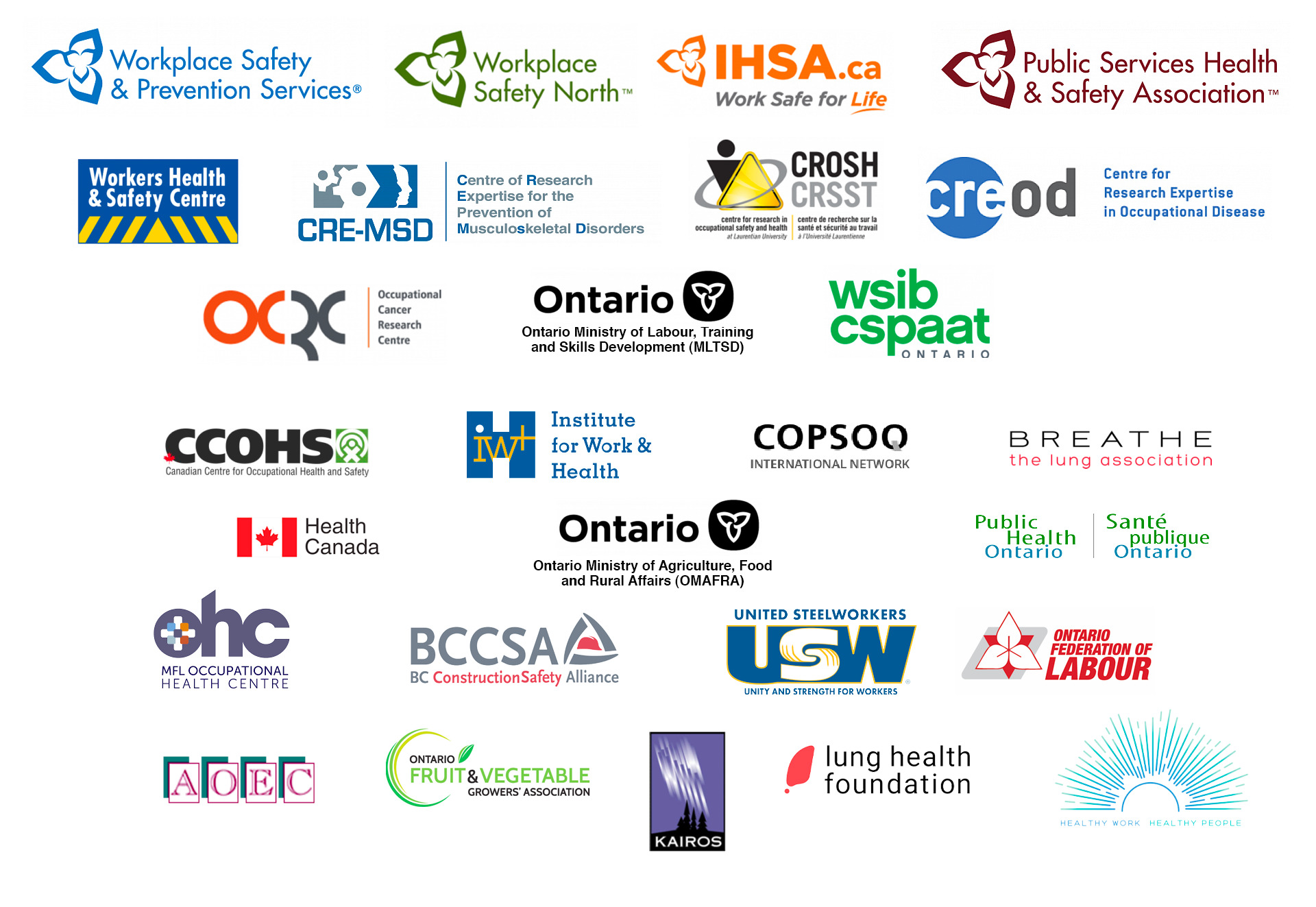
To learn more about these organizations, visit our Partners page.
The following PDF presents OHCOW's Audited Financial Statements for the 2021-2022 fiscal year:

